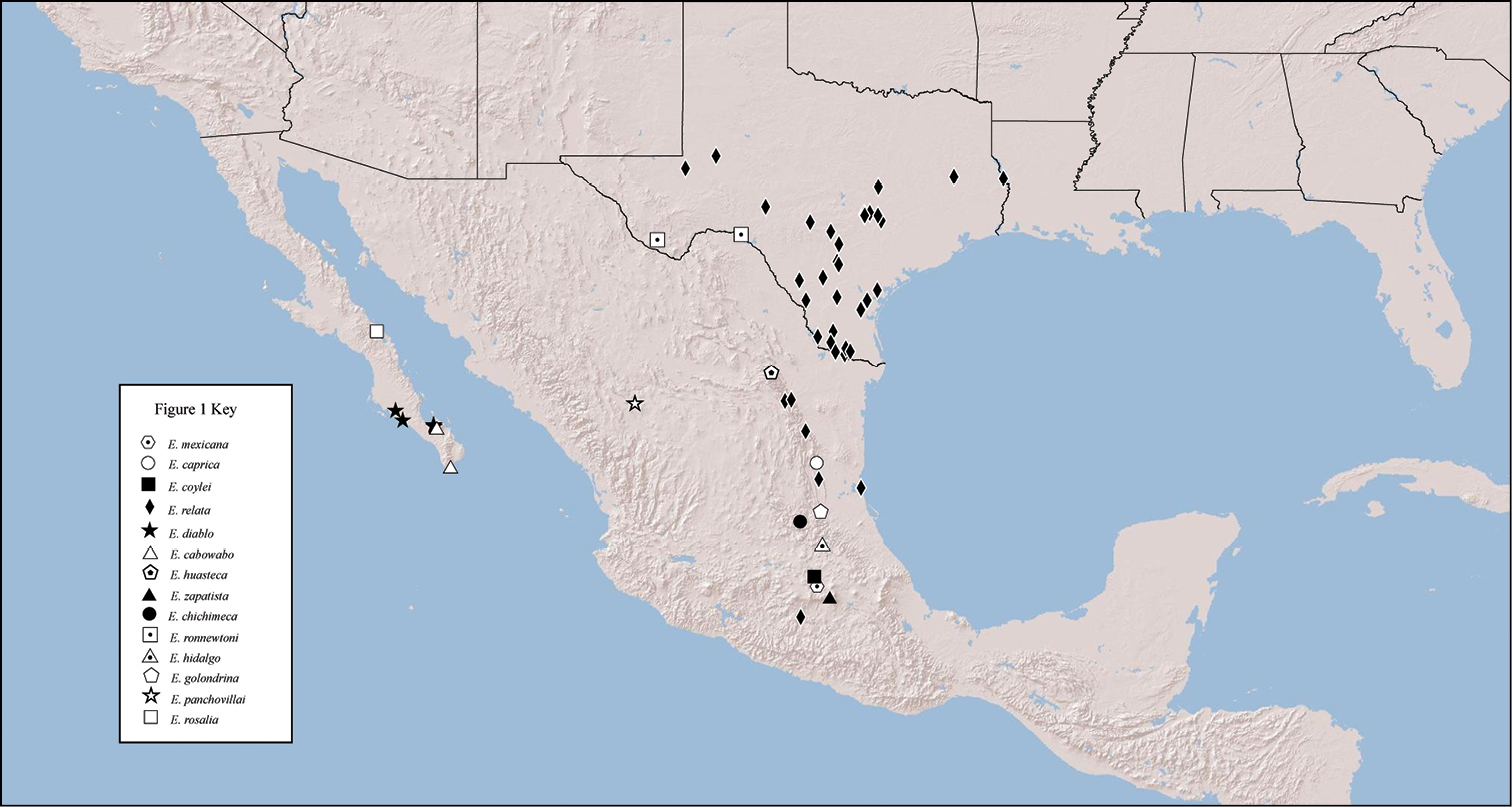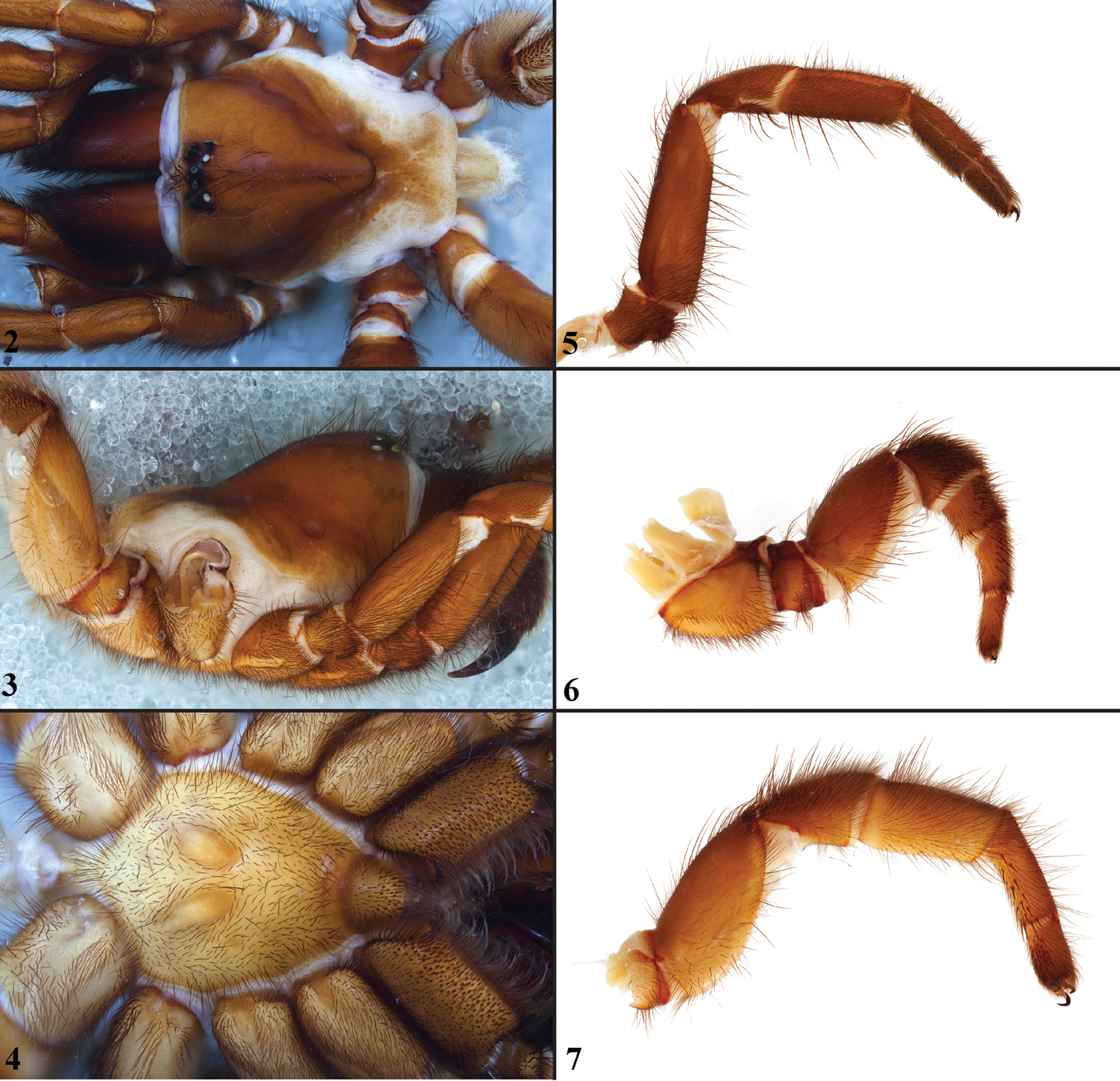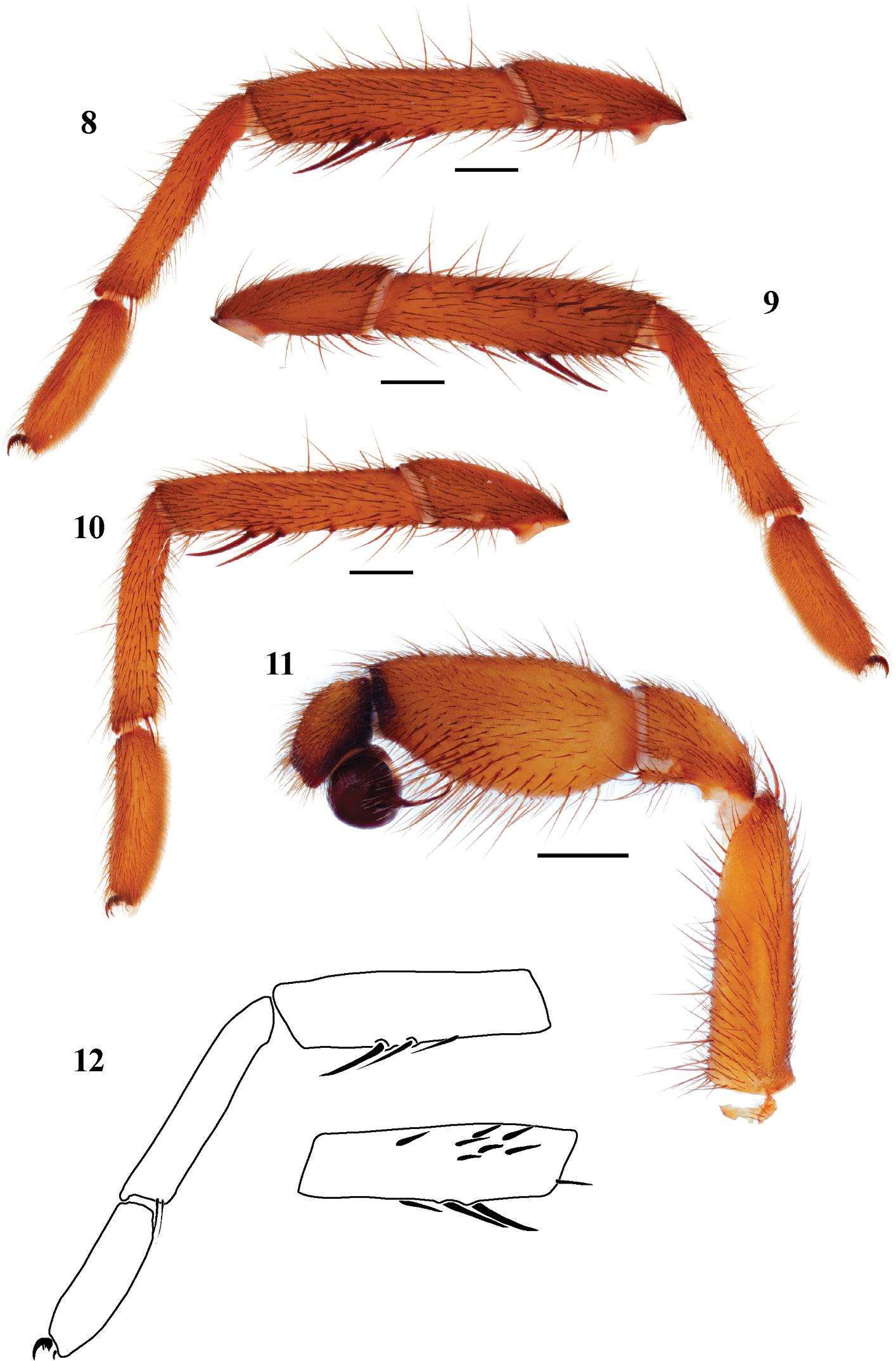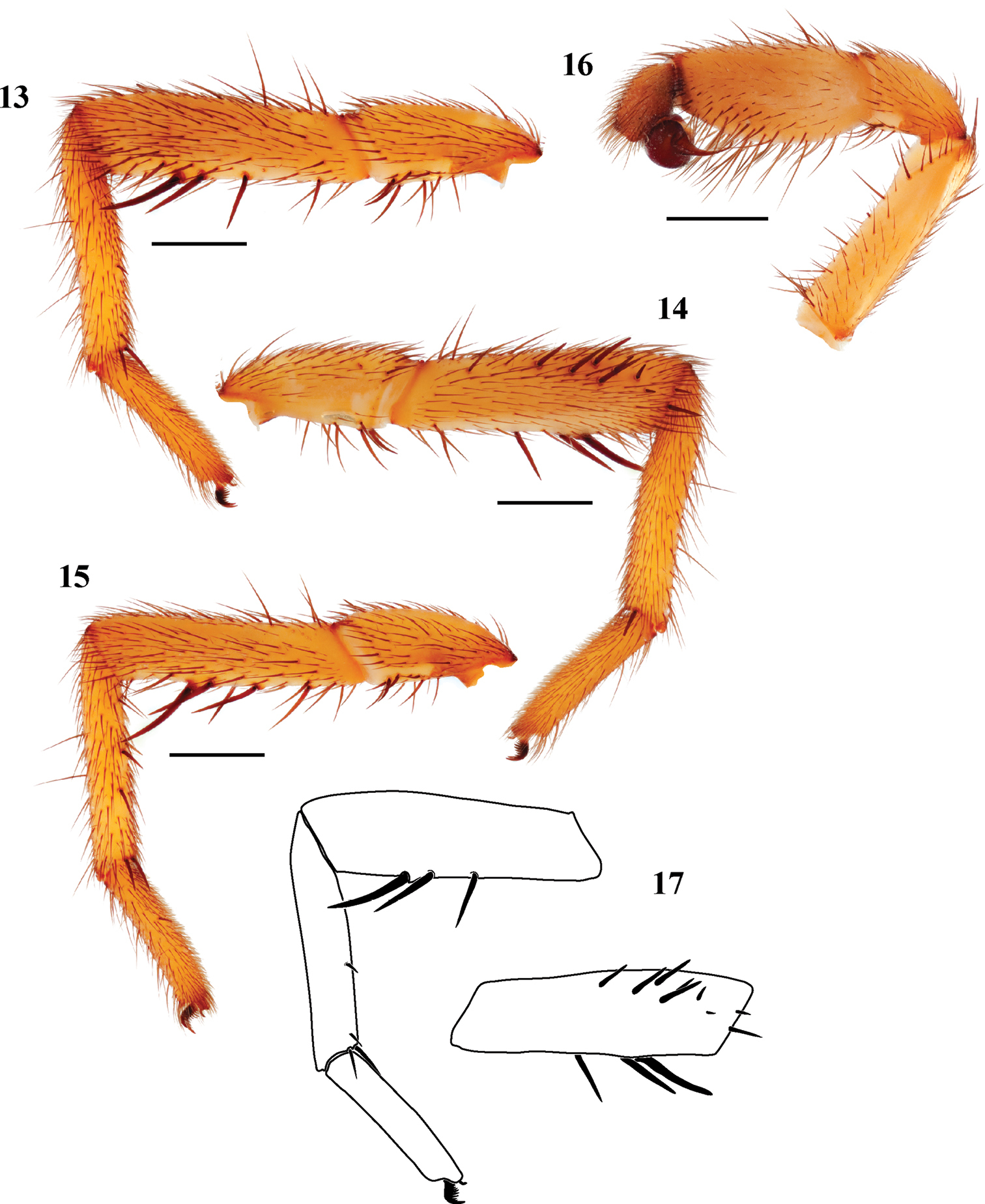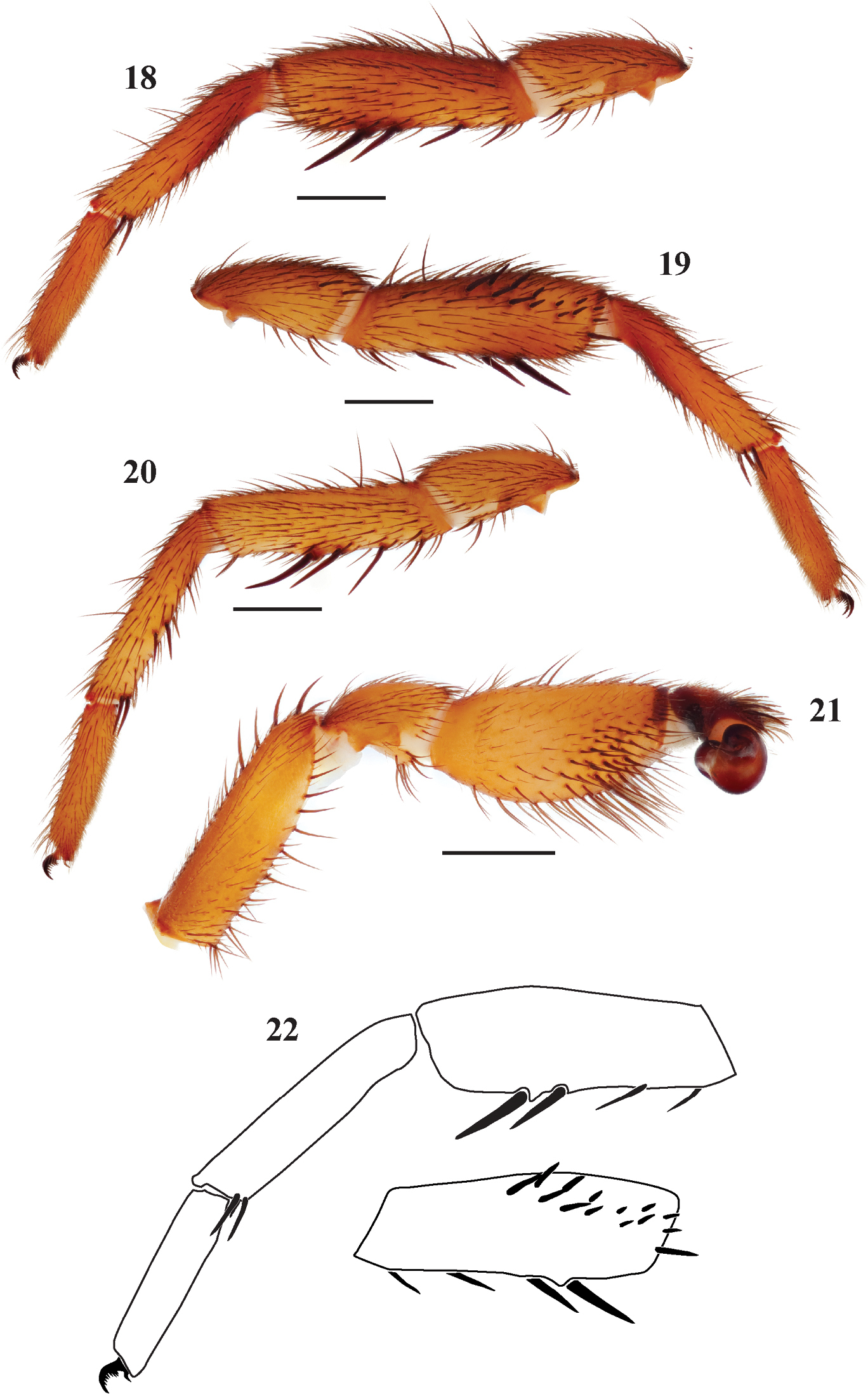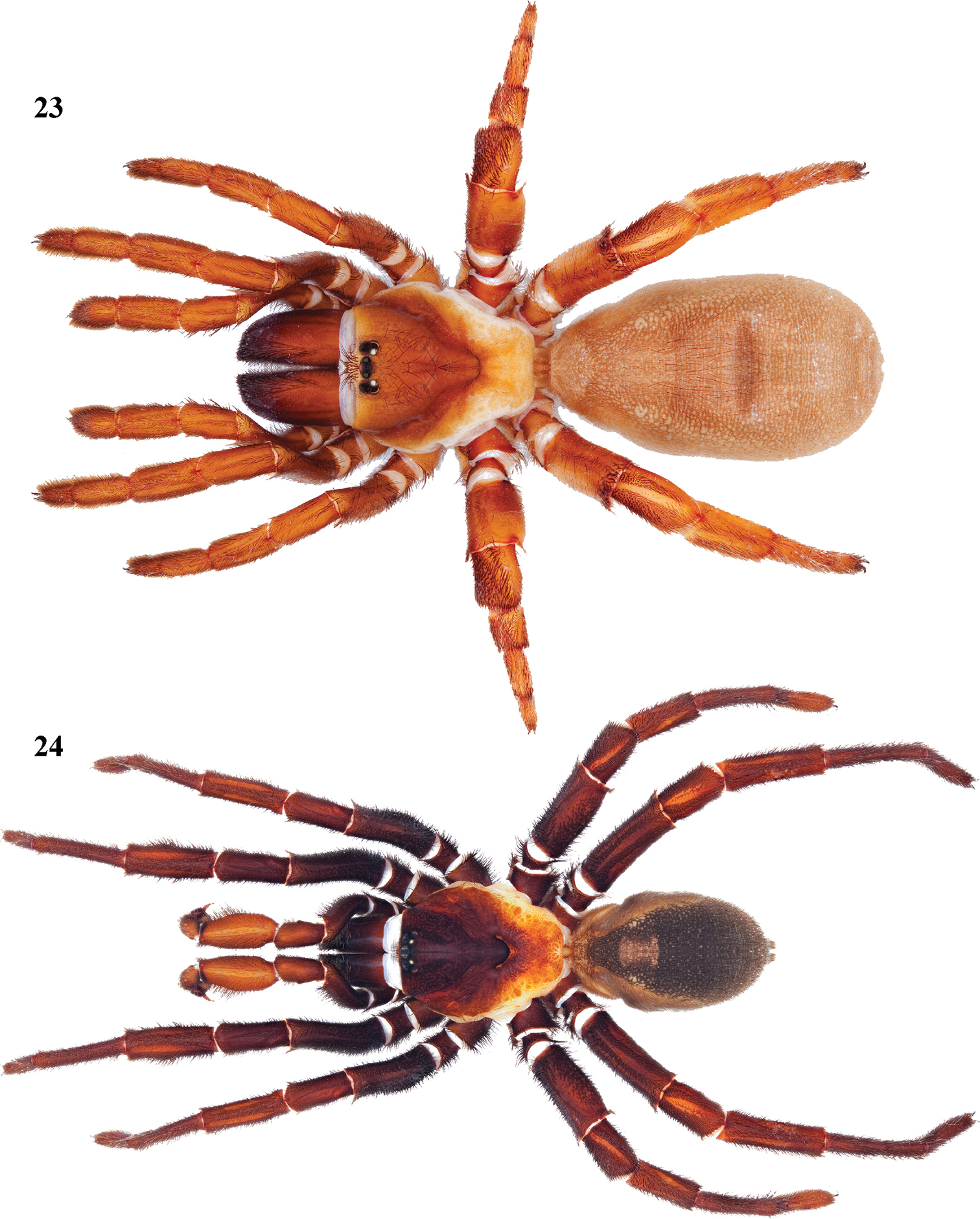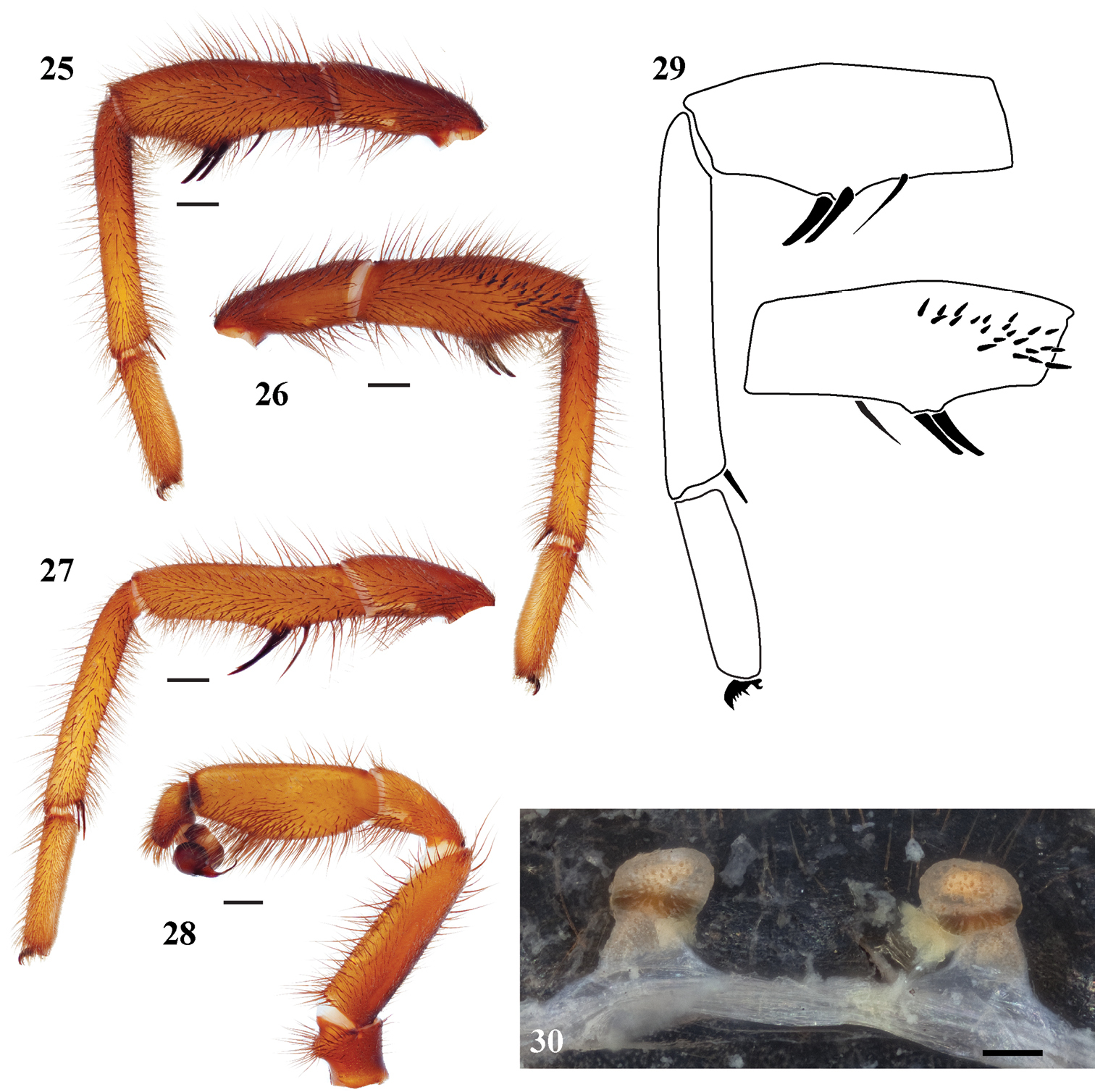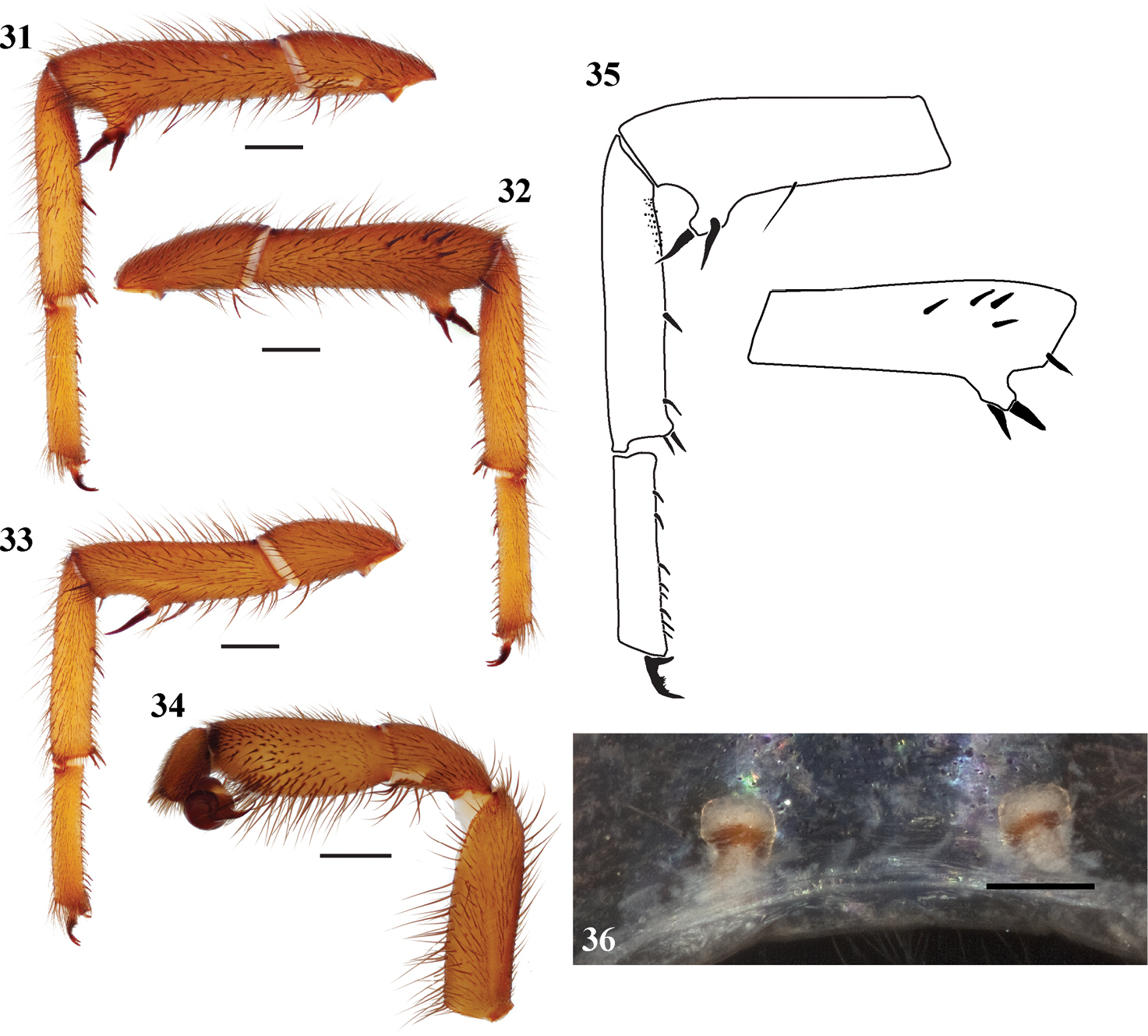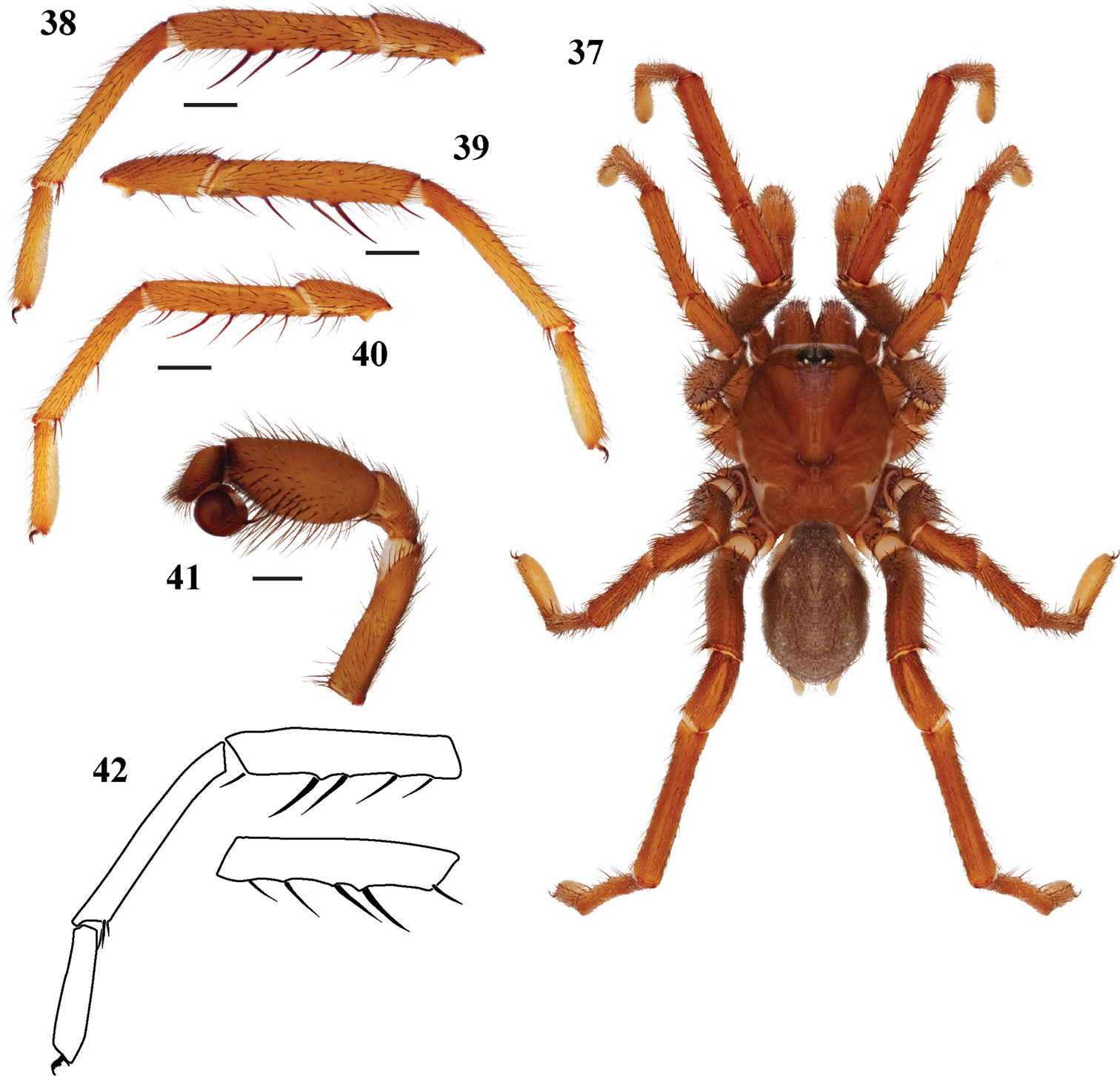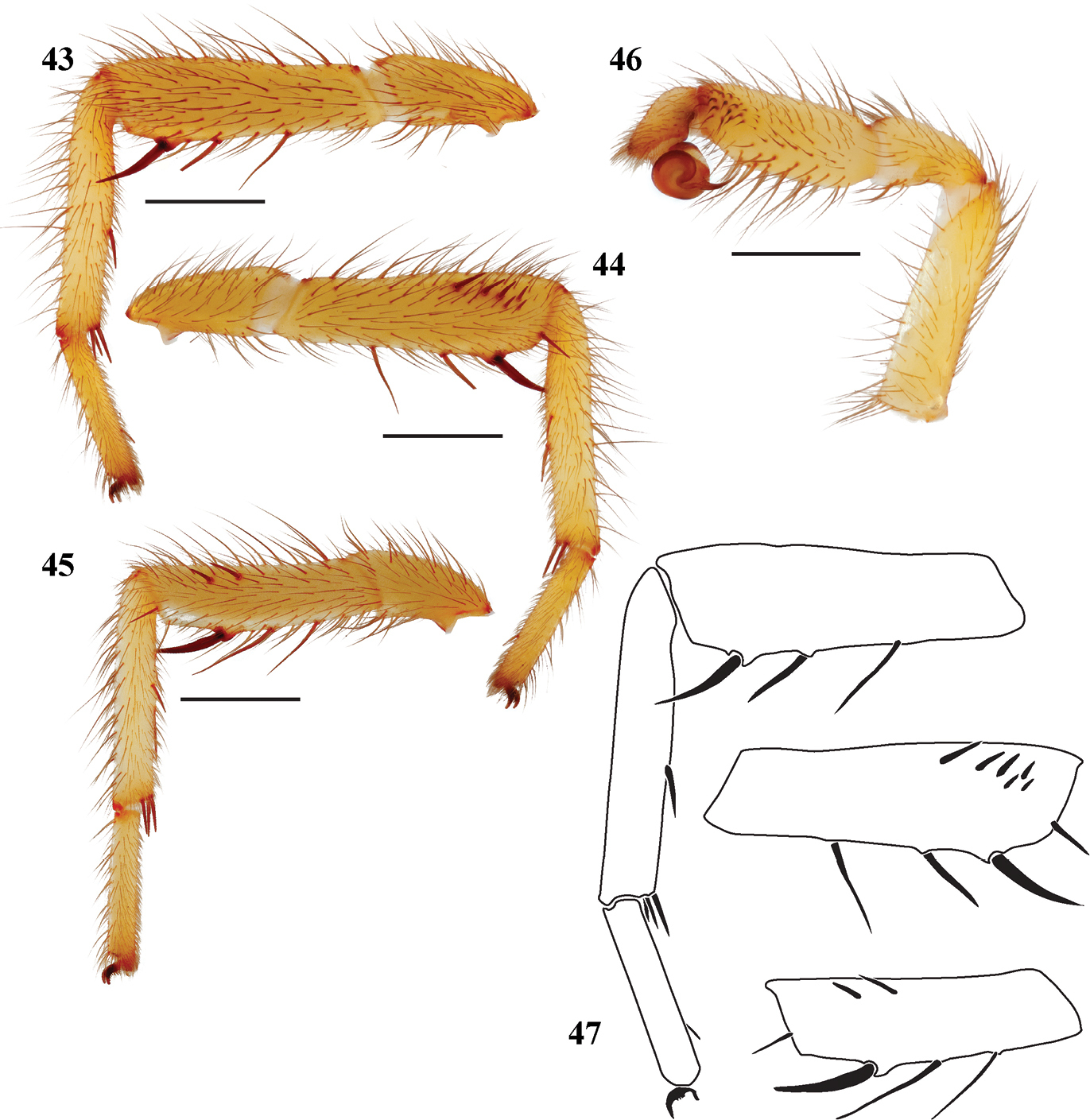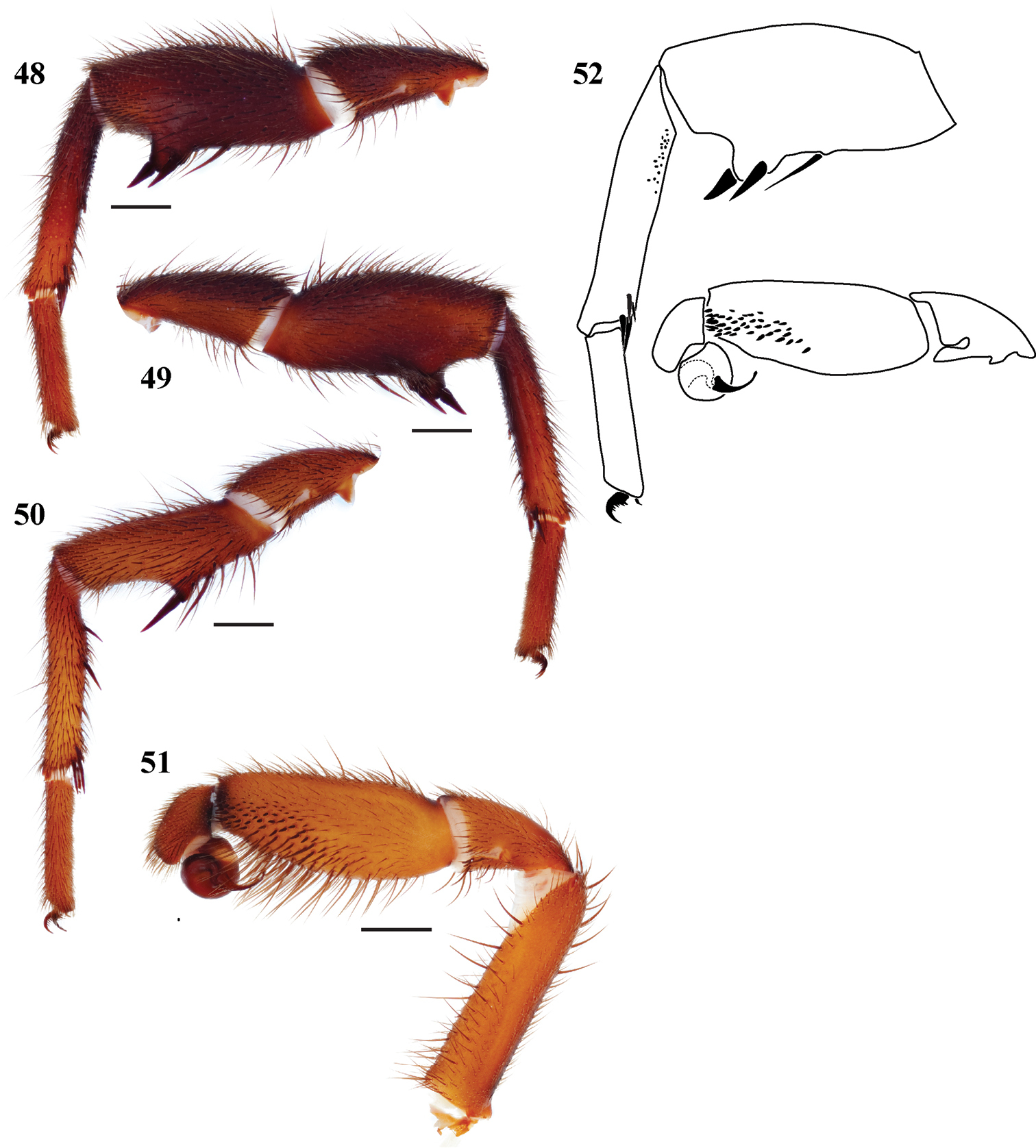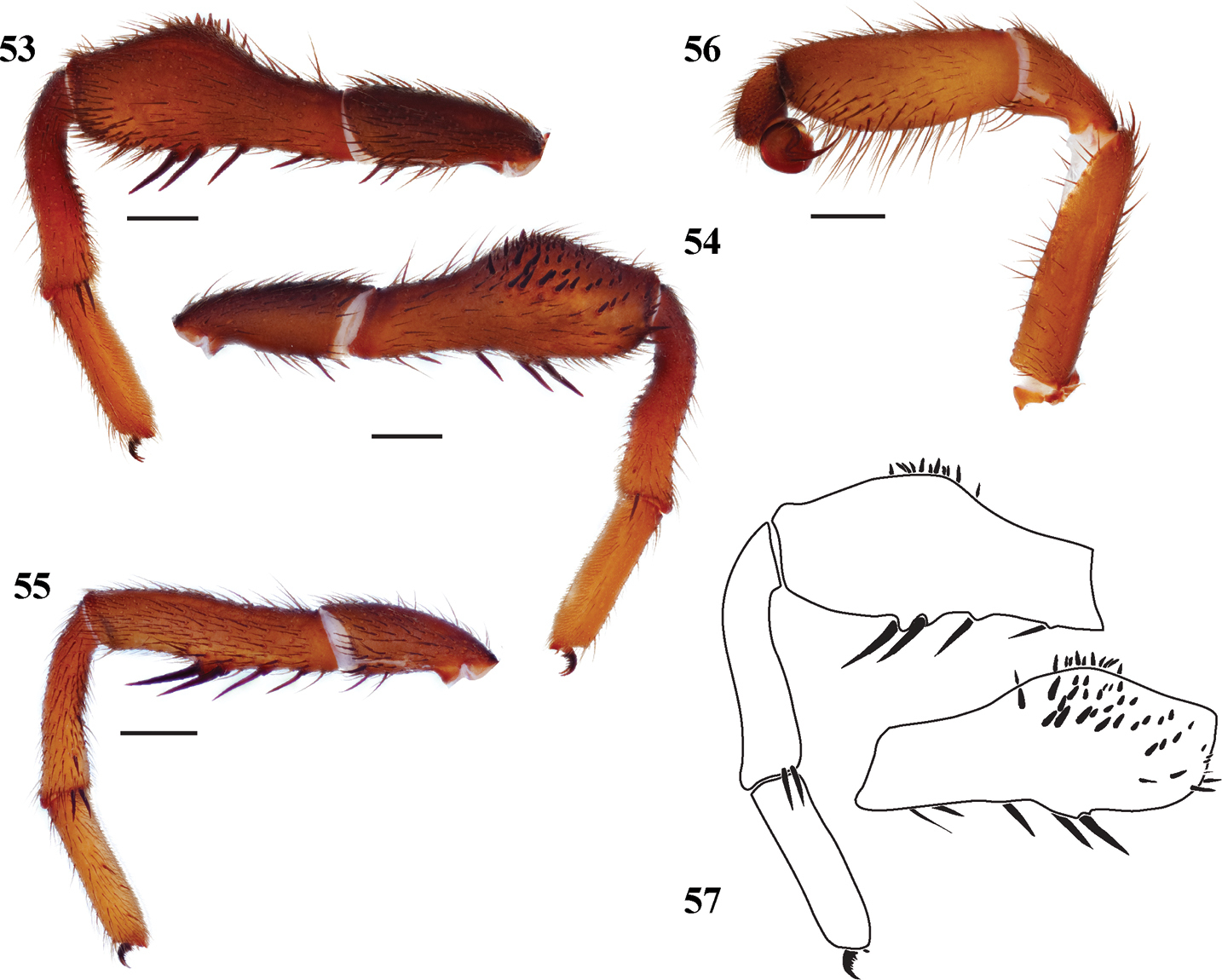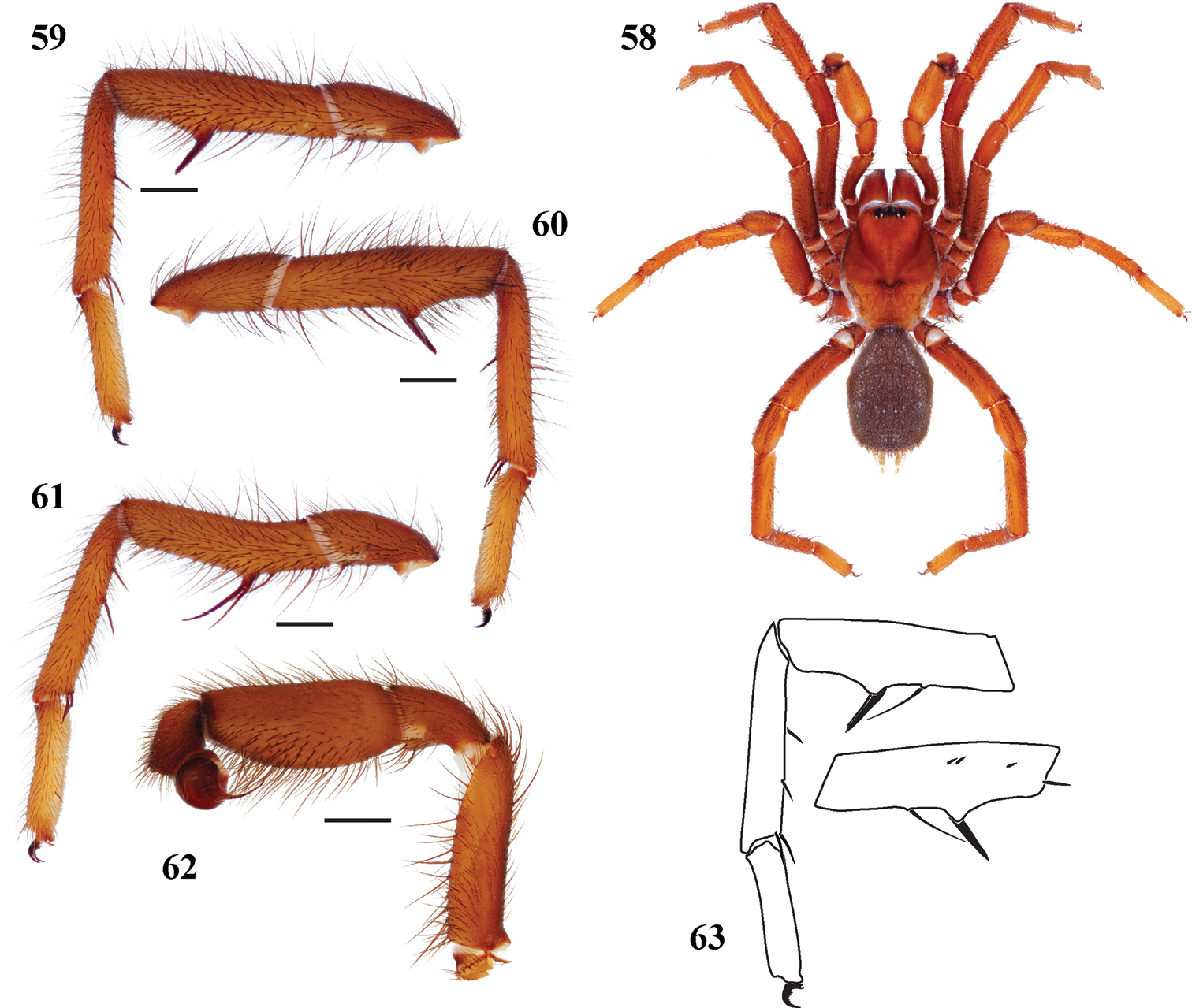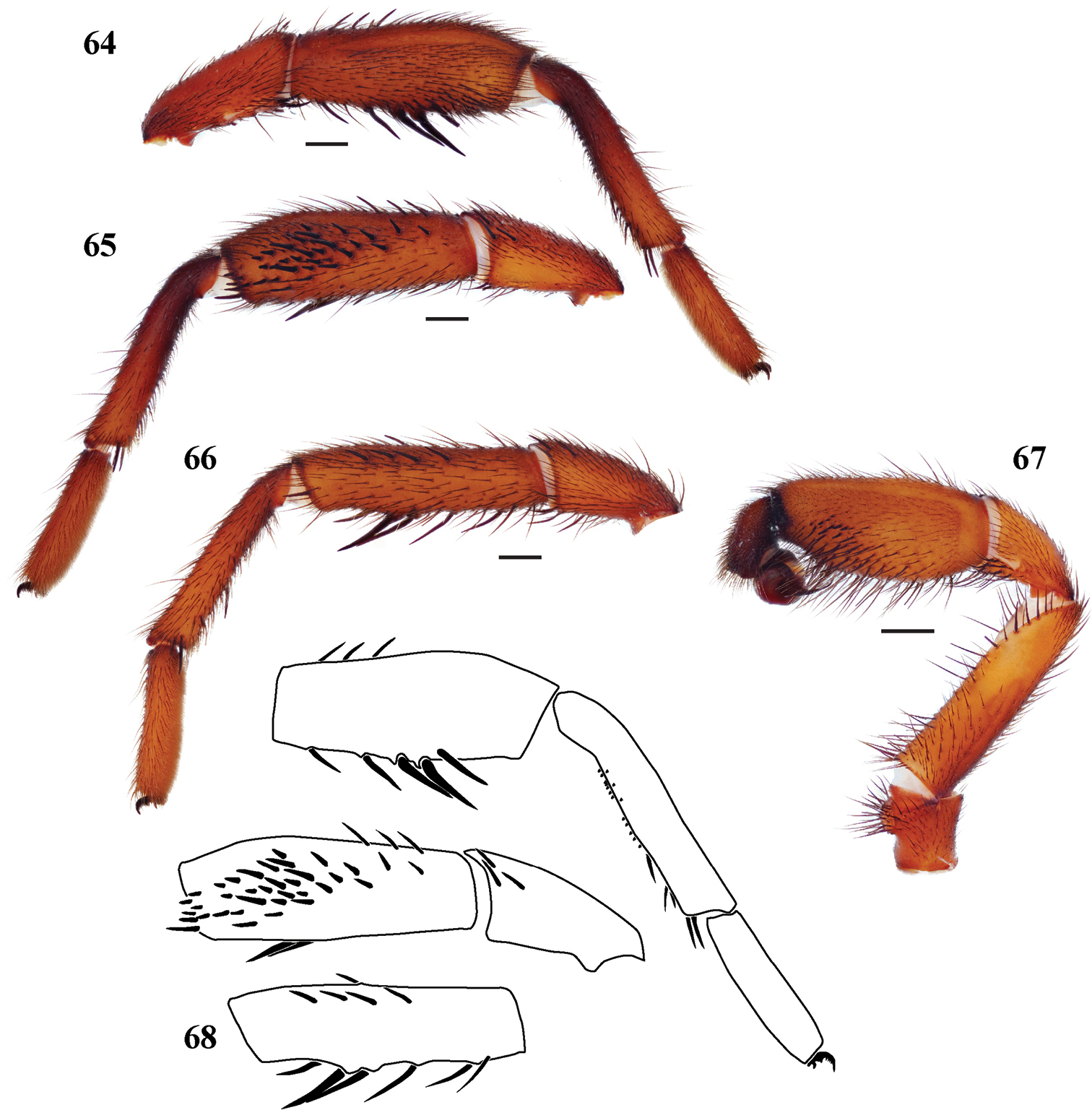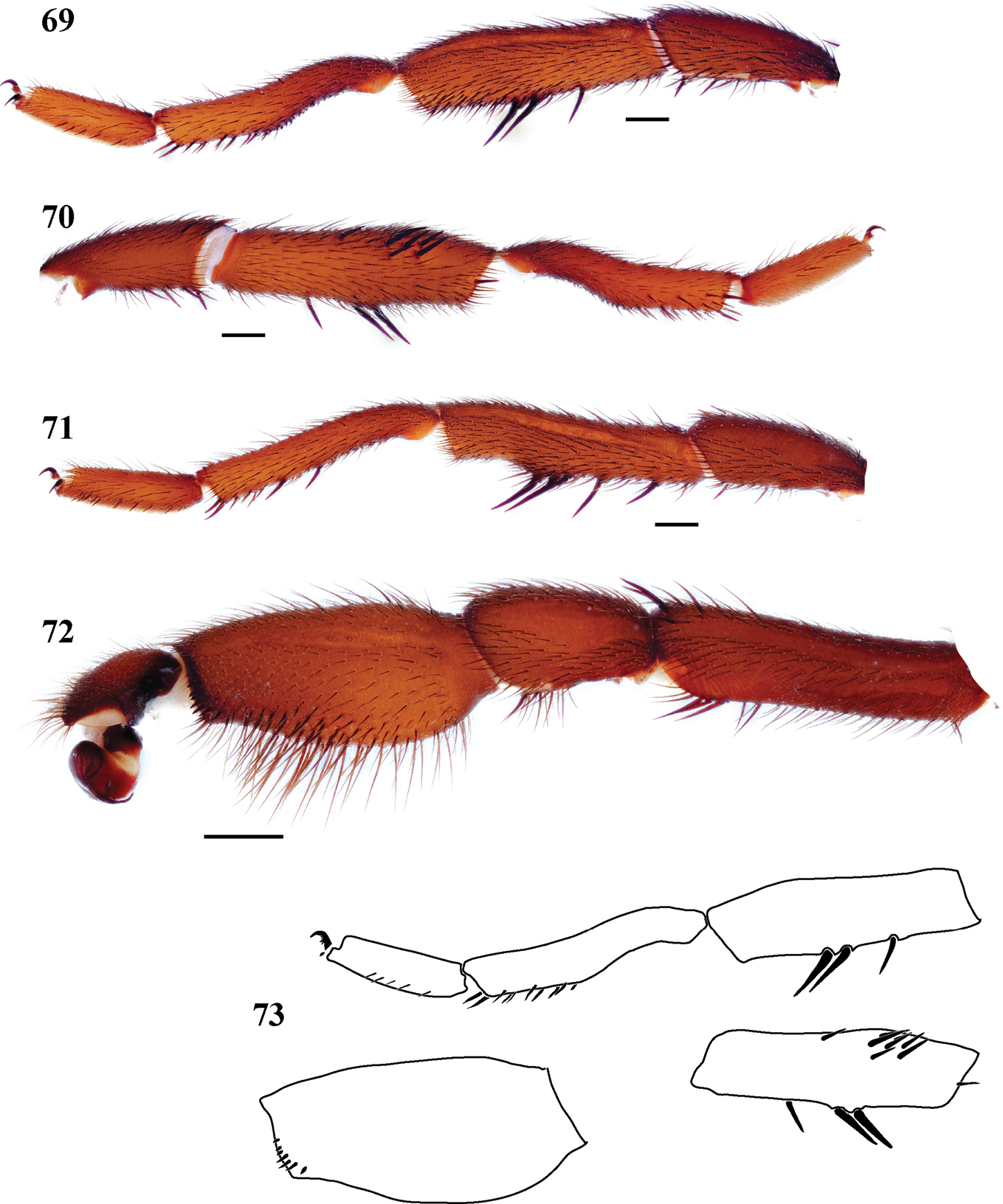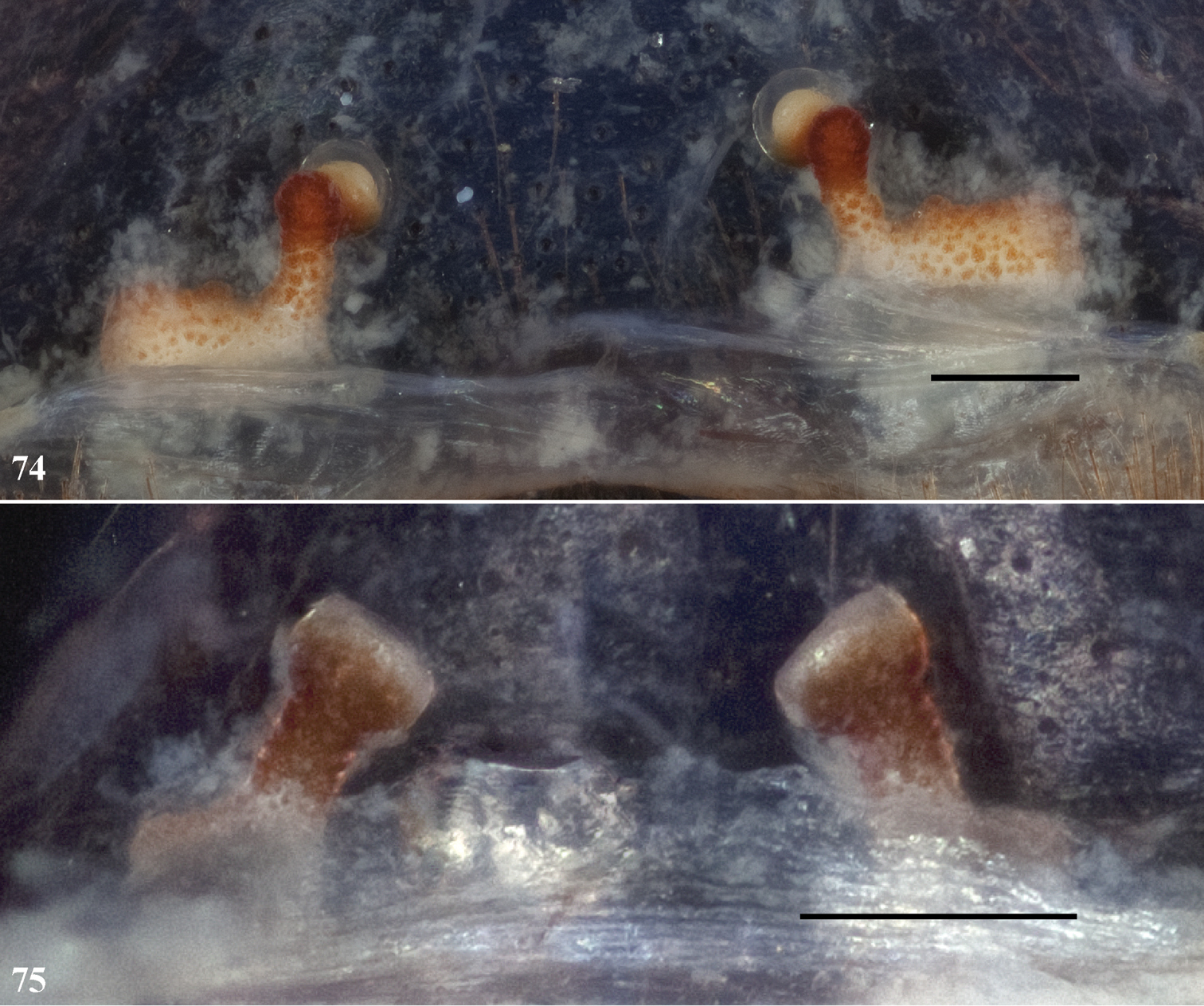






(C) 2013 Jason E. Bond. This is an open access article distributed under the terms of the Creative Commons Attribution License 3.0 (CC-BY), which permits unrestricted use, distribution, and reproduction in any medium, provided the original author and source are credited.
For reference, use of the paginated PDF or printed version of this article is recommended.
Citation: Bond JE, Godwin RL (2013) Taxonomic revision of the Trapdoor spider genus Eucteniza Ausserer (Araneae, Mygalomorphae, Euctenizidae). ZooKeys 356: 31–67. doi: 10.3897/zookeys.356.6227
The mygalomorph spider genus Eucteniza Ausserer, 1875 comprises 15 nominal species known only from the southwestern United States (Texas) and Mexico (Northern, Central, and the Baja Peninsula). Eucteniza atoyacensis Bond & Opell, 2002 is considered a nomen dubium; E. rex (Chamberlin, 1940) and E. stolida (Gertsch & Mulaik, 1940) are both considered junior synonyms of E. relata (O.P.-Cambridge, 1895). Twelve new species are described: E. caprica, E. coylei, E. diablo, E. cabowabo, E. huasteca, E. zapatista, E. chichimeca, E. ronnewtoni, E. hidalgo, E. golondrina, E. panchovillai and E. rosalia.
Biodiversity, new species, spider taxonomy, Eucteniza, Euctenizidae, Mygalomorphae
The trapdoor spider Eucteniza Ausserer, 1875 (subfamily Euctenizinae) is the most distinguishable of the genera currently placed in the recently recognized North American spider family Euctenizidae (see
Distribution of known Eucteniza species.
Phylogenetic placement of the genus has been historically problematic. Until recently, Eucteniza was the type genus for the cyrtaucheniid subfamily Euctenizinae (see
Like other euctenizid genera, the taxonomic history of Eucteniza is brief but does include a number of generic level synonyms. First described by
We present here the first species level taxonomic revision of the genus Eucteniza; this is the tenth paper in a series of taxonomic revisions and reviews and phylogenetic treatments undertaken by the first author (JEB) seeking to resolve the taxonomy of the North American euctenizid genera and species (
Species concept applied: Species were delineated using a traditional morphological species concept wherein species are defined as those populations (or groups of populations) that represent qualitative differences in phenotype that differ in a discrete manner from other populations or groups.
The following institutional and quantitative morphological abbreviations used in this paper are defined as follows:
AMNH (American Museum of Natural History; New York, New York), AUMNH (Auburn University Museum of Natural History; Auburn, Alabama), BMNH (British Museum of Natural History; London), CAS (California Academy of Sciences; San Francisco, California).
These features are explicitly defined and illustrated in
ANTd number of teeth on the anterior margin of the female cheliceral fang furrow
Cl, Cw carapace length and width. Carapace length taken along the midline dorsal most posterior position to the anterior front edge of the carapace (chelicerae are not included in length). Carapace width taken at the widest point
LBl, LBw labium length and width taken from the longest and widest points, respectively
PTl, PTw male palpal tibia length and width
Bl palpal bulb length from embolus tip to the bulb base, taken in the ventral plane at its longest point
PTLs, TBs number of female prolateral patella and tibial spines leg III
STRl, STRw sternum length and width. Sternum length from the base of the labium to its most posterior point. Width taken across the widest point, usually between legs II and III
TSrd, TSp, TSr number of tibia I spines on the distal most retrolateral, prolateral, and midline retrolateral positions
Unique voucher numbers were assigned to all specimens (alphanumeric designations beginning with EU, MY, or UMM); these data were added to each vial and can be used to cross-reference all images, measurements, and locality data. All measurements are given in millimeters and were made with a Leica M165c dissecting microscope equipped with the Leica Analysis Suite Software. Lengths of leg articles were taken from the mid – proximal point of articulation to the mid – distal point of the article (sensu
Mating clasper line drawings were first recorded as digital images and then traced as vector drawing objects using Adobe Illustrator (Adobe Systems Inc.). Digital images of specimens were made using a Visionary Digital Imaging System (Visionary DigitalTM, Richmond, VA) where images were recorded at multiple focal planes and then assembled into a single focused image using the computer program Helicon Focus (Helicon Soft, Ltd., Ukraine). The female genital region was removed from the abdominal wall and tissues dissolved using trypsin; spermathecae were examined and photographed in the manner described above. Following
Latitude and longitude for all collecting localities were recorded in the field using a Garmin® Global Positioning System receiver (Garmin International Ltd., Olathe, KS) using WGS84 map datum. For previously collected specimens (e.g., loaned museum specimens) locality data were georeferenced by hand by finding the approximate locality using Google Earth (WGS84 datum). A distribution map was constructed using ArcGIS using NAD83 map datum. Specimens without latitude and longitude data were georeferenced as described by
The data underpinning the analysis reported in this paper (see below) were deposited on 18 November 2013 in the Dryad Data Repository at doi: 10.5061/dryad.6dc14 and at GBIF, the Global Biodiversity Information Facility, http://ipt.pensoft.net/ipt/resource.do?r=eucteniza_data. Images associated with species descriptions have been deposited in Morphbank (http://www.morphbank.net); Morphbank image record numbers are noted in brackets by each figure in the figure legend.
Eucteniza Ausserer, 1875
Entychides Simon, 1888; Eucteniza Ausserer, 1875; Neoapachella Bond & Opell, 2002; Promyrmekiaphila Schenkel, 1950.
http://zoobank.org/F1037BA5-A80D-47F9-8F15-6937D62F89E4
http://species-id.net/wiki/Eucteniza
Figs 1–7Eucteniza males can be recognized by the presence of 1-2 mid-ventral megaspines on the tibia of both legs I and II (Figs 8–10). Such mating clasper spination configuration is similar to that of Neoapachella males for leg I but are absent on leg II. Females can be distinguished from all other euctenizid genera by having what appears to be a bi-dentate cheliceral furrow and a rastellum positioned on a moderate to high rastellar mound, whereas other genera have a single row of promarginal teeth and a small patch of denticles and lack a distinct rastellar mound. Additional Eucteniza autapomorphies include a patella IV spine patch and a weakly sclerotized posterior carapace margin.
Small to large sized trapdoor spiders. Cephalothorax longer than wide, sloping posteriorly, lacking pubescence in most species (Fig. 2). Posterior third of carapace very lightly sclerotized (Figs 2, 23, 24). Thoracic groove intermediate to wide, procurved (Fig. 2) and deep. Eyes not on a tubercle (Fig. 3). AME, PME subequal diameter. Posterior eye row slightly recurved, anterior eye row slightly porcurved (Fig. 2). Caput moderately high (Fig. 3). Carapace of ethanol preserved specimens appears most often reddish-brown, sometimes lighter. The coloration of living spiders tends to be a darker brown, however there is considerable variation in the intensity of coloration. Male coloration in most specimens is dark reddish-brown. Abdominal coloration light to dark brown, sometimes with dark mid dorsal blotch.
Standard light microscopy views of female Eucteniza relata (O.P.-Cambridge, 1895) from Hidalgo Co., TX. 2 dorsal view 3 side view 4 ventral view of sternum, labium and palpal endites 5 right leg I, retrolateral view 6 left leg III, prolateral view 7 left leg IV, prolateral view.
Sternum wider posteriorly, tapering anteriorly (Fig. 4). Posterior sigilla large and positioned mid-posteriorly nearly contiguous. Anterior margin of sigilla lacks rounded margin. Palpal endites longer than wide with numerous cuspules (Fig. 4). Labium wider than long, with numerous cuspules (Fig. 4). Chelicerae dark brown. Rastellum consists of numerous spines borne on a distinctive mound. Fangs of intermediate length and thickness. Cheliceral promargin with row of very large teeth; retromargin row comprises distinct row of large teeth interspersed with denticles.
Apical PLS article short, digitiform. Spinnerets mostly with pumpkiniform spigots with several articulated spigots interspersed on apical and median articles of PLS and the PMS (
Anterior leg articles slender relative to posterior. Tarsi short and robust (Figs 5–6). Female scopulae long, dense, asymmetrical, extending full length of tarsus, metatarsus and half length of tibia on anterior legs; posterior legs lack distinct scopulae. Male tarsi I and II with short sparse scopulae that are restricted to the ventral surface. Basal palpal tooth and STC I – IV basal tooth elongate and bifid. STC IV with 5 or more teeth. Female anterior legs with very few ventral spines (Fig. 5). Prolateral surface of female patella III and IV covered in numerous thick short spines (Fig. 6). Preening comb on metatarsus IV absent; metatarsus, tarsus IV with ventral spines (Fig. 7). Tarsal trichobothria arranged in a wide band with interspersed setae. Spermathecae generally comprise a simple unbranched bulb that lacks an elongate base.
Male mating clasper morphology is distinctive. Tibia legs I & II swollen mid-ventrally in most species, bearing 1-2 large spines; prolateral aspect with a small to large patch of smaller, thickened, short spines. Metatarsus of leg I lacks excavation and spur. Palpal bulb simple, with spherical base, planar distally near origin of embolus. Palpal cymbium lacks dorsal spines (Fig. 11).
Eucteniza mexicana Ausserer, 1875, male exemplar specimen from Mexico Distrito Federal, Mexico. 8 retrolateral aspect, leg I [831980] 9 prolateral aspect, leg I [831976] 10 retrolateral aspect, leg II [831982] 11 retrolateral aspect, pedipalp [831984] 12 line drawings, leg I retrolateral and prolateral (tibia) aspects.
Distributed primarily throughout central Mexico and Baja California (Fig. 1) with an extension northward into Texas (United States).
Note: as discussed by
| 1 | Tarsus swollen mid-ventrally, width wider than metatarsus (Fig. 8) | Eucteniza mexicana |
| – | Tarsus width subequal to metatarsus width | 2 |
| 2 | Tibia I swollen dorsally, behind tibia I metatarsus junction (Fig. 53) | Eucteniza chichimeca |
| – | Tibia I not swollen dorsally behind tibia I metatarsus junction | 3 |
| 3 | Ventral tibial megaspines borne on distinct apophysis (Fig. 31) | 4 |
| – | Ventral tibial megaspines not borne on a distinct apophysis | 5 |
| 4 | Tarsus I with short dorsal spines, tarsus III curved (Figs 31, 35) | Eucteniza diablo |
| – | Tarsus I lacks short spines, palpal tibia retrolateral surface with extensive spine patch (Figs 48, 51, 52) | Eucteniza zapatista |
| 5 | Metatarsus I with ventral microspines and subdorsal row of spines on prolateral surface tibia II (Figs 64, 66) | Eucteniza hidalgo |
| – | Metatarsus I lacking ventral microspines, and leg II prolateral spines on tibia | 6 |
| 6 | Palpal tibia with row of retrolateral spines at distal edge and metatarsus I with patch of distal ventral spines (Figs 69, 72, 73) | Eucteniza golondrina |
| – | Palpal tibia without row of retrolateral spines at distal edge; metatarsus lacks distinct ventral spines (numerous) | 7 |
| 7 | Very small (Cl < 3.5mm); very pale in coloration | Eucteniza huasteca |
| – | Typically larger in size (Cl > 4.00mm); darker in color | 8 |
| 8 | Leg I metatarsus as long as or subequal in length to tibia; tibia slender with thin ventral megaspines (Fig. 37) | Eucteniza cabowabo |
| – | Leg I tibia shorter than metatarsus, ventral megaspines typically thicker and tibia not slender (usually swollen mid-ventrally) | 9 |
| 9 | Leg I prolateral tibial spines are longer in length | 10 |
| – | Leg I prolateral tibial spines are shorter in length | 11 |
| 10 | Leg I prolateral tibial spines fewer (10), longer in length, and thinner; spider paler in color (Fig. 14) | Eucteniza caprica |
| – | Leg I with more prolateral tibial spines (14) which are relatively shorter in length and stouter (Fig. 19) | Eucteniza coylei |
| 11 | Tibia I with very few prolateral spines (< 4) with few (1) spines situated distally (Fig. 60) | Eucteniza ronnewtoni |
| – | Tibia I with larger number of prolateral spines (>3) with spines more evenly distributed distally to proximally (Fig. 26) | Eucteniza relata |
http://species-id.net/wiki/Eucteniza_mexicana
Figs 1, 8–12Male exemplar (EU008) from Mexico Distrito Federal, Mexico, 19.4327, -99.13478, elev. 2249m, coll. J. Honey, deposited in AMNH.
Eucteniza mexicana is similar to Eucteniza coylei and Eucteniza caprica in appearance but has more stout tarsi on leg I (Figs 8–10, 12) and fewer prolateral leg I tibial spines that are short and thick; prolateral tibial spines on the other two species are longer and thinner.
Specimen preparation and condition. Specimen preserved in 70% EtOH. Pedipalp, legs I, II removed, stored in vial with specimen. Color faded. General coloration. Carapace dark reddish brown 2.5YR 2.5/4. Abdomen very dark brown 7.5YR 2.5/3. Cephalothorax. Carapace 6.707 long, 5.548 wide, sparsely setose, pars cephalica slightly elevated. Fringe sparse. Foveal groove deep, procurved. Tubercle absent. AER slightly procurved. PER slightly recurved. AME slightly larger in diameter than PME. Sternum moderately setose, STRl 3.825, STRw 3.401. Posterior sternal sigilla very large, not contiguous, medial pair of anterior sigilla moderate in size and inset, anterior pair small and marginal. Chelicerae with anterior tooth row comprising 7 large teeth, posterior margin with single row of 9 small teeth. Palpal endites with numerous cuspules across endite face, labium with 7-9 cuspules, LBw 1.086, LBl 0.613. Rastellum consists of 7 small spines on a small mound. Abdomen. Moderately setose. Legs. Leg I: 6.087, 3.050, 4.303, 3.920, 2.572; leg IV: 6.341, 2.824, 4.771, 5.836, 3.508. Dense scopulae on legs I-II. Tarsus I with wide band of 14 trichobothria. Leg I spination pattern (Figs 8, 9, 12); TSp 8, TSr 0, TSrd 0; leg II with two ventral thin megaspines. Pedipalp. PTw 1.570, PTl 2.908, Bl 1.430. Embolus arises sharply from bulb and tapers quickly, geniculate at tip (Fig. 11).
Known only from the exemplar specimen and juvenile holotype
Highly imprecise, Mexico; exemplar specimen from Mexico Distrito Federal (Fig. 1).
http://zoobank.org/2664B285-A666-43EB-9735-62FF425E1026
http://species-id.net/wiki/Eucteniza_caprica
The ‘Caprica-Six Trapdoor Spider’
Figs 1, 13–17Male holotype (EU106) from Tamaulipas, Mexico, 23.0303, -99.14785, elev. 335m, coll. G. Farias 13.iii.1972, deposited in AMNH.
The specific epithet is a noun taken in apposition and is in reference to the humanoid cylon model Caprica 6, portrayed by Tricia Helfer in the remake of the science fiction series Battlestar Galactica.
Eucteniza caprica is similar to Eucteniza mexicana in appearance but is smaller in size and lighter in coloration, leg I tarsi are not nearly as stout (Figs 13–15, 17).
Eucteniza caprica sp. n. male holotype specimen from Tamaulipas, Mexico. 13 retrolateral aspect, leg I [832084] 14 prolateral aspect, leg I [832080] 15 retrolateral aspect, leg II [832086] 16 retrolateral aspect, pedipalp [832088] 17 line drawings, leg I retrolateral and prolateral (tibia) aspects.
Specimen preparation and condition. Specimen preserved in 70% EtOH. Pedipalp, legs I, II removed, stored in vial with specimen. Color faded. General coloration. Carapace strong brown 7.5YR 5/6. Abdomen light yellowish brown 10YR 6/4. Cephalothorax. Carapace 4.712 long, 4.041 wide, sparsely setose, pars cephalica slightly elevated. Fringe sparse with 2-3 heavy setae at posterior corners. Foveal groove deep, procurved. Tubercle absent. AER slightly procurved. PER slightly recurved. AME slightly larger in diameter than PME. Sternum moderately setose, STRl 2.615, STRw 2.301. Posterior sternal sigilla very large, elongate, not contiguous, anterior sigilla pair not visible. Chelicerae with anterior tooth row comprising 6 large teeth, posterior margin with single row of 3 small teeth. Palpal endites lacking cuspules across endite face, labium lacking cuspules, LBw 0.892, LBl 0.548. Rastellum consists of 5 small spines not on a mound. Abdomen. Moderately setose. Legs. Leg I: 4.583, 2.141, 2.930, 2.872, 1.862; leg IV: 5.227, 2.113, 4.124, 4.557, 2.763. Light scopulae on legs I-II. Tarsus I with wide band of 15 trichobothria. Leg I spination pattern (Figs 13, 14, 17); TSp 10, TSr 0, TSrd 0. Pedipalp. PTw 0.985, PTl 1.942, Bl 0.932. Embolus arises sharply from bulb and tapers quickly, slightly flared at tip (Fig. 16).
Known only from the male holotype specimen.
Known only from the type locality, Tamaulipas, Mexico (Fig. 1).
http://zoobank.org/F183B402-2346-4296-8DFD-6D1324216110
http://species-id.net/wiki/Eucteniza_coylei
‘Coyle’s Trapdoor Spider’
Figs 1, 18–22Male holotype (EU009), from Morelos, Mexico, 0.8km W Tepozitlán, Rt 1150 on rd to Ocotepec, 18.9889, -99.11168, 1822m, coll. F. Coyle 10.vi.1982. Male holotype deposited in AMNH.
The specific epithet is a patronym in honor of arachnologist Fred Coyle who collected the type specimen.
Eucteniza is similar in appearance to Eucteniza mexicana but has thinner tarsi and short tibia I (Figs 19, 22) prolateral spines that are concentrated distally whereas Eucteniza mexicana lacks short distal spines on tibia I.
Eucteniza coylei sp. n. male holotype specimen from Morelos, Mexico. 18 retrolateral aspect, leg I [831990] 19 prolateral aspect, leg I [831986] 20 retrolateral aspect, leg II [831992] 21 retrolateral aspect, pedipalp [831994] 22 line drawings, leg I retrolateral and prolateral (tibia) aspects.
Specimen preparation and condition. Specimen preserved in 70% EtOH. Pedipalp, legs I, II removed and stored in vial with specimen. Color faded. General coloration. Carapace dark red 2.5YR 3/6. Abdomen reddish black 2.5YR 2.5/1. Cephalothorax. Carapace 4.75 long, 4.00 wide, glabrous, pars cephalica moderately elevated. Fringe of sparse black setae. Foveal groove deep, procurved. AER slightly procurved, PER straight. AME and PME subequal. Sternum moderately setose, STRl 2.83, STRw 2.76. Posterior sternal sigilla large, not contiguous, anterior sigilla pairs small and marginal. Chelicerae with anterior row comprising 6 large teeth, posterior margin with a patch of approximately 12 small teeth. Palpal endites and labium without cuspules, LBw 0.79, LBl 0.58. Rastellum consists of 8 spines. Abdomen. Setose, thin, fine black setae. Legs. Leg I 4.20, 2.20, 2.88, 2.56, 1.84; leg IV: 4.30, 2.00, 3.75, 3.80, 2.25. Light scopulae on legs I, II. Tarsus I with 10 widely spaced trichobothria. Leg I spination pattern (Figs 19, 20, 22); TSp 14, TSr 0, TSrd 0. Pedipalp. PTw 1.58, PTl 2.00, Bl 1.45. Embolus relatively short, flared at tip (Fig. 21).
Known only from the type specimen.
Known only from the male holotype specimen.
Known from the type locality in Morelos, Mexico (Fig. 1).
http://species-id.net/wiki/Eucteniza_relata
‘The Southwestern Trapdoor Spider’
Figs 1, 23–30Eucteniza relata mating clasper morphology comprises 2 large, tightly grouped megaspines on the mid-ventral aspect of tibia I; few (4) to many prolateral distal spines (21); tibia I medially swollen (Figs 25, 26, 29).
Eucteniza relata (O.P.-Cambridge, 1895) from Kingsville, Texas 23 female habitus illustration [832092] 24 male habitus illustration [832056].
Eucteniza relata (O.P.-Cambridge, 1895) from Kingsville, Texas 25–29 male specimen 25 retrolateral aspect, leg I [832050] 26 prolateral aspect, leg I [832046] 27 retrolateral aspect, leg II [832052] 28 retrolateral aspect, pedipalp [832054] 29 line drawings, leg I retrolateral and prolateral (tibia) aspects 30 cleared spermathecae, scale bar = 0.1mm [832096].
Eucteniza relata described by
Variation (males, 6). Cl 8.07-11.53, 9.59±0.47; Cw 7.26-9.76, 8.28±0.37; STRl 4.73-5.98, 5.3±0.19; STRw 4.34-6.01, 5.06±0.26; LBw 1.18-1.56, 1.4±0.06; LBl 0.78-1.14, 0.98±0.05; leg I: 7.39-9.3, 8.24±0.28; 3.86-5.09, 4.44±0.18; 5.04-6.38, 5.41±0.22; 5.55-7.23, 6.38±0.26; 2.78-3.99, 3.34±0.18; leg IV: 7.74-9.88, 8.58±0.32; 3.98-5.15, 4.41±0.16; 5.98-7.93, 6.67±0.3; 6.47-9.02, 7.62±0.36; 3.64-5.31, 4.49±0.27; PTl 4.19-5.31, 4.64±0.16; PTw 1.87-2.25, 2.06±0.05; Bl 1.54-2.45, 1.89±0.13; TSp 4-21, 9.33±2.54; TSr 0-0, 0±0; TSrd 0-0, 0±0;
Variation (females, 6). Cl 7.55-10.01, 8.61±0.45; Cw 6.39-7.94, 7.31±0.31; STRl 4.4-5.89, 4.98±0.27; STRw 4.13-5.23, 4.68±0.21; LBw 1.39-1.98, 1.62±0.11; LBl 0.96-1.39, 1.16±0.08; Leg I: 13.54-20.45, 17.11±1.23; ANTd 6-8, 7.2±0.37; PTLs 45-80, 63.6±7.02; TBs 16-36, 23.8±3.29.
Mexico: Guerrero: Taxco, 18.5351, -99.60986, 1621m, V Roth, W Gertsch 29.vii.1956 [EU030, 1♂, AMNH]; Nuevo Leon: Cerro Potosi, Galeana, 24.8811, -100.23275, 3713m, S & J Peck 26.vi.1969 [EU061, 1♀, AMNH]; 20mi W of Linares, 24.8666, -99.88486, 1894m, S Mulaik 1.ix.1956 [EU074, 2♀, AMNH]; Tamaulipas: Conrado Castillo, 23.9500, -99.46676, 1955m, P Sprouse v.1980 [EU003, 1♀, AMNH]; Antiguo Morelos, Mexico, 22.5500, -99.08335, 205m, JA Beatty 21.vi.1963 [EU036, 1♂, AMNH]; Tampico, Mexico, 22.3000, -97.85005, 10m, Ekhomb 1942 [EU013, 1♀, AMNH]. United States: Texas: Atascosa Co.: 28.8333, -98.50007, 106m, C Rutherford 31.xii.1936 [EU062, 1♀, AMNH]; Jourdanton, 28.9178, -98.54613, 140m, C Rutherford [EU046, 1♀, AMNH]; Jourdanton, 28.9178, -98.54613, 140m, C Rutherford 27.xi.1935 [EU058, 1♀, AMNH]; Bastrop Co.: Bastrop State Park, 30.1122, -97.26063, 168m, B Hunsacker 26.iii.1958 [EU029, 1♀, AMNH]; Little Sandy Creek 10mi NW of Bastrop, 30.2601, -97.35553, 125m, B Vogel 4.x.1971 [EU064, 1♂, AMNH]; Bell Co.: Temple, 31.0981, -97.34276, 221m, M Hatley x.2006 [EU084, 1♂, TAMU]; Bexar Co.: San Antonio, 29.4239, -98.49337, 198m, L Griffith 15.xii.1939 [EU049, 1♂, AMNH]; San Antonio, 29.424, -98.48336, 199m, L Gonzales 10.xii.1987 [EU088, 1♂, TAMU]; San Antonio, 29.424, -98.48336, 199m, L Monney 20.x.1989 [EU089, 1♂, TAMU]; San Antonio, 29.424, -98.48336, 199m, R Uasquez 15.xi.1992 [EU090, 1♂, TAMU]; Dimmit Co.: 3mi NW of Catarina, 28.3747, -99.01071, 166, BE Hendrixson, M Capes, M Roberts 12.iii.2000 [EU092, 1♀, AUMNH]; Duval Co.: 4mi E of Freer, 27.8828, -98.54945, 186m, EG Riley 11.x.2003 [EU085, 1♂, TAMU]; Hidalgo Co.: Mission, 26.2156, -98.3253, 43m [EU007, 1♀, AMNH]; Edinburg, 26.3014, -98.16313, 29m, S Mulaik [EU026, 1♀, AMNH]; Edinburg, 26.3014, -98.16313, 29m, S Mulaik [EU033, 1♀, AMNH]; Edinburg, 26.3014, -98.16313, 29m, S Mulaik 1.iii.1936 [EU027, 1♀, AMNH]; Edinburg, 26.3014, -98.16313, 29m, S Mulaik 1.v.1937 [EU048, 1♀, AMNH]; Edinburg, 26.3014, -98.16313, 29m, S Mulaik 27.ii.1939 [EU050, 1♀, 1 juv, AMNH]; Edinburg, 26.3014, -98.16313, 29m, S Mulaik 1.iii.1938 [EU032, 2 juv, AMNH]; Edinburg, 26.3014, -98.16313, 29m, D Mulaik 5.vi.1939 [EU039, 1♂, AMNH];Edinburg, 26.3014, -98.16313, 29m, 24.xii.1949 [EU040, 1♀, AMNH]; Edinburg, 26.3014, -98.16313, 29m, S Mulaik 15.iv.1936 [EU042, 1♀, AMNH]; Edinburg, 26.3014, -98.16313, 29m, S Mulaik 31.xii.1934 [EU044, 069, 2♀, AMNH]; Houston Co.: Old Tyler Rd near Ratcliff, 31.3914, -95.13946, 122m, SFA Student 23.ix.1968 [EU022, 1♀, AMNH]; Kendall Co.: Boerne, 39.7945, -98.73196, 429m, ND Masters 20.ix.1994 [EU086, 1♀, TAMU]; Kennedy Co.: 50mi NW of Edinburg, 26.8796, -98.66427, 154m, 24.ii.1949 [EU023, 1♀, AMNH]; Kerr Co.: Raven Ranch, 30.0666, -99.33337, 546m, J McHenry 27.vi.1941 [EU053, 1♀, AMNH]; Kleberg Co.: Kingsville, 27.5156, -97.85586, 18m, [EU063, 1♂, AMNH, EU037, 1♂, AMNH]; Kingsville, 27.5156, -97.85586, 18m, JC Cross 31.xii.1944 [EU065, 1♂, AMNH]; Kingsville, 27.5156, -97.85586, 18m, JC Cross 1.xi.1947 [EU066, 1♂, AMNH]; LaSalle Co.: 9mi W of Fowlerton on Hwy 97, 28.4534, -98.95984, 110m, EG Riley 11.x.2003 [EU099, 1♂, AUMNH]; Midland Co.: Midland, 31.9973, -102.07796, 848m, M Dilley Summer 2002 [EU082, 1♂, AUMNH]; Nueces Co.: Robstown, 27.7900, -97.66866, 21m, 14.x.1968 [EU035, 1♂, AMNH]; Robstown, 27.7900, -97.66866, 21m, Richard 10.ix.1968 [EU055, 1♂, AMNH]; Sabine Co.: 9mi E of Hemphill, “Beech Bottom”, 31.3405, -93.69485, 58m, Anderson, Morris 15.xi.1985 [EU087, 1♀, 2♂, TAMU]; San Patricio Co.: 8mi NE of Sinton, 28.087, -97.37415, 10m, HE Laughlin 15.x.1959 [EU019, 1♂, AMNH]; Starr Co.: 26.5666, -98.73337, 135m, V Wilder 25.ix.1940 [EU043, 1♀, AMNH]; Near Hwy 83, 2.5mi W of Sullivan City, 26.2894, -98.59384, 58m, WR Icenogle 6.ix.1974 [EU067, 1♂, AUMNH]; Sutton Co.: 30.5166, -100.63337, 647m, L Pierce 17.ii.1973 [EU005, 1♂, AMNH]; Travis Co.: SRD University of Texas Campus, 30.2918, -97.73853, 168m, WH McAlister 10.ii.1956 [EU006, 1♀, AMNH]; 5mi E of Austin, 30.3392, -97.59266, 183m, WF Blair 21.i.1957 [EU020, 1♂, AMNH]; Austin, 30.2669, -97.74283, 153m, 1.iii.2005 [EU034, 1♀, AMNH]; Austin, 30.2669, -97.74283, 153m, Casteel 3.xii.1945 [EU041, 1♂, AMNH]; Austin, 30.2669, -97.74283, 153m, 29.xi.1945 [EU054, 1♀, AMNH]; Austin, 30.2669, -97.74283, 153m, 31.xii.1971 [EU070, 1♀, 2♂, AMNH]; Austin Caverns, 30.2969, -97.77436, 152m, B Russel 3.x.1964 [EU072, 1♂, AMNH]; Austin, 30.2669, -97.74283, 153m, 31.xii.2003 [EU076 Paratype, 1♀, AMNH]; Austin, 30.2671 Austin, 30.26716, 148m, J Heskett xii.2003 [EU083, 1♂, TAMU]; Austin, 30.2671 Austin, 30.26716, 148m, 1.vii.1983 [UMM460, 1♂, AMNH]; Ward Co.: 5mi N of Monahans, 31.6352, -102.97275, 808m, J Brown 7.xi.1993 [EU051, 1♂, AMNH]; Webb Co.: Near Hwy 83, 1.8mi N of jct w/Hwy 35, 27.7889, -99.45571, 213m, JE Bond 7.viii.1997 [EU107, 1♀, AUMNH]; Near Hwy 83, 1.8mi N of jct w/Hwy 35, 27.7889, -99.45571, 213m, JE Bond 7.viii.1997 [EU057, 077, 078, 079, 4♀, AMNH]; Near Hwy 83, 1.8mi N of jct w/Hwy 35, 27.7889, -99.45571, 213m, WR Icenogle 8.ix.1974 [EU016, 1♀, AUMNH]; Near Hwy 83, 1.8mi N of jct w/Hwy 35, 27.7889, -99.45571, 213m, WR Icenogle 8.ix.1974 [EU059, 1♀, AUMNH]; Zapata Co.: 35mi NW of Rio Grande City on Rt 83, 26.7299, -99.11243, 350m, S Mulaik [EU045, 1♀, 2 juv, AMNH].
Widely distributed throughout Texas and northern/central Mexico (Fig. 1).
Without doubt this species, as circumscribed herein, represents multiple species, likely cryptic. Until additional data are available (e.g., molecules) we have chosen to be conservative and strictly apply a morphological species concept as described above.
http://zoobank.org/C250C475-64A2-4568-A2ED-C97F9DF8E9E6
http://species-id.net/wiki/Eucteniza_diablo
‘The Baja California Trapdoor Spider’
Figs 1, 31–36Male holotype (EU081), from Mexico, Baja California Sur, 3.2km S of La Paz, 24.103, -110.3075, 58m 10.viii.1966; additional male paratypes (EU095) from Baja California Sur, Mexico, El Sombrero Trailer Park in La Paz, 24.1331, -110.29985, 47m 3.vii.1968, coll. M. Bentzien; additional female paratype (EU102) from Mexico, Baja California Sur, 2mi S of Santa Rita, 24.572, -111.43644, 36m 16.xi.1968, coll. E.L. Sleeper and F.J. Moore. Male holotype and male and female paratypes deposited in AMNH.
The specific epithet is a noun taken in apposition and is in reference to the highest peak on the Baja Peninsula, “Picacho del Diablo”.
Male Eucteniza diablo specimens can be differentiated from all other species in the genus by having, in combination, leg I tibia megaspines borne on a mid-ventral apophysis, small microspines on the ventral distal aspect of metatarsus, short ventral spines on tarsus I, and a curved tarsus III (Figs 31, 32, 35). Similar to Eucteniza zapatista but lacking retrolateral spines on male palpal tibia (Fig. 34).
Eucteniza diablo sp. n. from Mexico, Baja California Surmale holotype and female paratype 31–35 male specimen 31 retrolateral aspect, leg I [832074] 32 prolateral aspect, leg I [832070] 33 prolateral aspect, right leg II [832076] 34 retrolateral aspect, pedipalp [832078] 35 line drawings, leg I retrolateral and prolateral (tibia) aspects 36 cleared spermathecae, scale bar = 0.1mm [832098].
Specimen preparation and condition. Specimen preserved in 80% EtOH. Multiple legs removed, stored in vial with specimen. Coloration faded. General coloration. Carapace dark reddish brown 2.5YR 3/4. Abdomen yellowish red 5YR 4/6. Cephalothorax. Carapace 6.31 long, 5.15 wide, glabrous, no distinct fringe, pars cephalica moderately elevated. Foveal groove strongly procurved, deep and shelf-like. Eyes without tubercle. AER slightly procurved, PER straight. AME, PME subequal, AME slightly smaller and PLE reduced in size, very small. Sternum with light setae, STRl 3.56, STRw 3.12. Posterior sternal sigilla in center, not contiguous, irregular shape, medial anterior sigilla pair inset, anterior pair marginal. Chelicerae with anterior tooth row comprising 5 large teeth, posterior margin with single row of 7 teeth. Palpal endites with cuspules distributed across entire face, labium with 14 cuspules, LBw 1.12, LBl 0.81. Rastellum consists of 8 spines. Abdomen. Moderate to dense setation. Legs. Leg I: 5.65, 2.50, 4.10, 3.95, 2.70; leg IV: 5.75, 2.50, 4.75, 5.00, 3.05. Very light scopulae on legs I, II. Tarsus leg III slightly curved, microspines on metatarsus proximal to junction with tibia; small spines on tarsus I ventral surface (Figs 31, 32, 35); TSp 4, TSr 0, TSrd 0. Pedipalp. PTw 1.28, PTl 2.50, Bl 1.31 (Fig. 34).
Known only from the type specimens.
Specimen preparation and condition. Specimen preserved in same manner as male holotype. Color. Carapace dark red 2.5YR 3/6. Spinnerets light yellow. Cephalothorax. Carapace 6.3 long, 5.9 wide, glabrous. Lacks fringe. Foveal groove deep and procurved. Tubercle absent. AER very slightly procurved, PER straight. AME, PME subequal. Sternum moderately setose, STRl 4.40, STRw 3.65. Posterior sigilla large and nearly contiguous, medial anterior sigilla relatively large and positioned more towards center. Chelicerae anterior tooth row armed with 6 teeth with posterior margin comprising 4 teeth. Palpal cuspules numerous and widespread across endites; labium with 12 cuspules, LBw 1.14, LBl 0.88. Rastellum consists of 10 spines positioned on a mound. Walking legs. Leg I 14.43 long. Tarsus I with 12 widely scattered trichobothria. Legs I, II with heavy, asymmetric scopulae. PTLs 32, TBs 15. Preening combs absent. Spermathecae simple bulb (Fig. 36).
Mexico: Baja California Sur: 27.3mi S Santa Rita, 24.2548, -111.23765, 29m, SC Williams, J Bigelow, M Bentzien 27.vii.1968 [EU097, 1♂, AMNH]; La Paz city limits, 24.1331, -110.29985, 8m, SC Williams, MA Cazier, M Bentzian, WK Fox, J Bigelow 13.vii.1968 [EU094, 1♂, AMNH].
Known from the La Paz municipality of Baja California Sur, Mexico (Fig. 1).
http://zoobank.org/CE5B7237-6056-4899-BA7B-67CC0AE7F4AB
http://species-id.net/wiki/Eucteniza_cabowabo
‘The Cabo Wabo Trapdoor Spider’
Figs 1, 37–42Male holotype and female paratype (EU096), from Baja California Sur, Mexico, 8mi SE of La Paz, 24.0338, -110.23314, 287m, coll. E. L. Sleeper, F. J. Moore 13.x.1968. Male holotype and female paratype deposited in AMNH.
The specific epithet is a noun taken in apposition inspired by Sammy Hagar’s club and restaurant, Cabo Wabo, in Cabo San Lucas.
Male Eucteniza cabowabo specimens differ from all other Eucteniza specimens by having a very slender leg I tibia and metatarsus with thin ventral megaspines (Figs 3–40, 42); PME’s reduced in size. The single Eucteniza cabowabo female paratype lacks PME’s; due to the lack of specimens it is not clear whether this is a diagnostic feature or the specimen is aberrant.
Eucteniza cabowabo sp. n. from Mexico, Baja California Surmale holotype 37 habitus [832094] 38 retrolateral aspect, leg I [832064] 39 prolateral aspect, leg I [832060] 40 retrolateral aspect, leg II [832066] 41 retrolateral aspect, pedipalp [832068] 42 line drawings, leg I retrolateral and prolateral (tibia) aspects.
Specimen preparation and condition. Specimen preserved in 70% EtOH. Pedipalp, leg I, and leg II left side removed, stored in vial with specimen. Coloration faded. General coloration. Carapace dark reddish brown 2.5YR 2.5/4 (Fig. 37). Abdomen very dusky red 2.5YR 2.5/2. Cephalothorax. Carapace 5.25 long, 4.19 wide, glabrous, lacks fringe, pars cephalica low. Foveal groove deep and procurved. Tubercle absent. AER slightly procurved, PER slightly recurved. AME slightly larger in diameter than PME. Sternum moderately setose, STRl 3.04, STRw 2.48. Posterior sternal sigilla large, irregularly shaped, and contiguous, medial pair anterior sigilla more centrally positioned, irregularly shaped. Chelicerae with anterior tooth row comprising 6 teeth, posterior margin with single straight row of 4 teeth. Lacks palpal and labium cuspules, LBw 0.83, LBl 0.45. Rastellum consists of 8 spines. Abdomen. Moderately setose. Legs. Leg I: 5.44, 2.38, 3.88, 4.19, 2.31; leg IV: 5.69, 2.38, 4.69, 4.75, 3.19. Light scopulae on legs I, II, III, IV. Tarsus with 10 trichobothria, widely spread. Leg I spination; TSp 3, TSr 0, TSrd 0 (Figs 38, 39, 42). Pedipalp. PTw 1.36, PTl 2.60, Bl 1.35 (Fig. 41).
Known only from the type specimens and one other male.
Specimen preparation and condition. Specimen preserved in same manner as male holotype. Color. Carapace dark red 2.5YR 3/6. Spinnerets light yellow. Cephalothorax. Carapace 7.0 long, 4.81 wide, glabrous. Lacks fringe. Foveal groove deep and procurved. Tubercle absent. AER very slightly procurved, PER straight. PME absent. Sternum moderately setose, STRl 4.60, STRw 3.20. Posterior sigilla large and nearly contiguous, medial anterior sigilla relatively large and positioned more towards center. Chelicerae anterior tooth row armed with 6 teeth with posterior margin comprising 4 teeth. Palpal cuspules numerous and widespread across endites; labium with 12 cuspules, LBw 1.26, LBl 0.77. Rastellum consists of 14 spines positioned on a mound. Walking legs. Leg I 12.40 long. Tarsus I with 12 widely scattered trichobothria. Legs I, II with heavy, asymmetric scopulae. PTLs 25, TBs 16. Preening combs absent. Spermathecae not with specimen, presumed lost.
Known only from the female paratype specimen.
Mexico: Baja California Sur: 6mi E of Cabo San Lucus, 22.9248, -109.81874, 12m, H Ridgeway 13.i.1974 [EU093, 1♂, AMNH].
Known from La Paz and Los Cabos municipalities of Baja California Sur, Mexico (Fig. 1).
http://zoobank.org/2E8ECBC1-E7D7-469C-AEE1-975C8BD0520E
http://species-id.net/wiki/Eucteniza_huasteca
‘The Huasteca Canyon Trapdoor Spider’
Figs 1, 43–47Male holotype (EU052), from Nuevo Leon, Mexico, at La Huasteca Canyon, 3mi SW of Santa Catarina, 25.6544, -100.50754, 1114m, coll. L. Malarat 11.viii.1978; deposited in AMNH.
The specific epithet is a noun taken in apposition and is in reference to the type locality.
Male Eucteniza huasteca type specimen differs from all other Eucteniza species on the basis of its very small size, very pale yellow coloration, and by having a distinct patch of spines on the distal aspect of the palpal tibia (Figs 43, 44, 47); other species are typically larger in size, darker in coloration, and lack similar palpal tibia spination.
Eucteniza huasteca sp. n. from Nuevo Leon, Mexico male holotype 43 retrolateral aspect, leg I [832040] 44 prolateral aspect, leg I [832036] 45 retrolateral aspect, leg II [832042] 46 retrolateral aspect, pedipalp [832044] 47 line drawings, leg I retrolateral and prolateral (tibia) aspects; prolateral aspect tibia leg II.
Specimen preparation and condition. Specimen preserved in 70% EtOH. Pedipalp, legs I, II removed, stored in vial with specimen. Coloration faded. General coloration. Carapace yellowish red 5YR 5/8. Abdomen reddish yellow 7.5YR 6/8. Cephalothorax. Carapace 3.48 long, 2.53 wide, glabrous with sparse posterior fringe, pars cephalica low. Foveal groove procurved. Eyes slightly elevated. AER straight, PER slightly recurved. AME and PME subequal. Sternum with long setae, STRl 2.06, STRw 1.50. Posterior sternal sigilla large and elongate, but separated, anterior pairs marginal, difficult to see. Chelicerae with anterior tooth row comprising 6 teeth, posterior margin with 3 small denticles. Palpal endites and labium lack cuspules, LBw 0.54, LBl 0.28. Rastellum consists of 6 spines. Abdomen. Long thin setae. Legs. Leg I: 3.09, 1.47, 2.22, 2.22, 1.34; leg IV: 3.13, 1.25, 3.03, 2.81, 1.47. Very light scopulae on legs I-II. Tarsus with 4 trichobothria. Leg I spination pattern; TSp 6, TSr 0, TSrd 0 (Figs 43, 44, 47); Leg II spination pattern Figs 45, 47. Pedipalp. PTw 0.56, PTl 1.41, Bl 0.73. Embolus slender (Fig. 46).
Known only from the type specimen.
Known only from the male holotype specimen.
Known from Nueva Leon, Mexico, at La Huasteca Canyon (Fig. 1).
http://zoobank.org/D1B109F8-8692-4CCC-BBA6-57FF7EDAAFE2
http://species-id.net/wiki/Eucteniza_zapatista
‘The Zapatista Trapdoor Spider’
Figs 1, 48–52Male holotype (EU012), from Paso de Cortes, Puebla, Mexico, 19.1167, -98.76676, 3000m, coll. C. Bolivar 18.vii.1943. Male holotype deposited in AMNH.
The specific epithet is a noun taken in apposition and is in reference to the common name used for the Mexican Liberation Army of the South (Ejército Libertador del Sur) led by Emiliano Zapata (1879-1919).
Male Eucteniza zapatista leg I morphology is similar to Eucteniza diablo however it lacks tarsal spines and has a more inflated or swollen tibia (Figs 48, 49, 52). Males can be further distinguished from all other species by having an extensive patch of spines on the retrolateral distal aspect of the palpal tibia (Figs 51, 52).
Eucteniza zapatista sp. n. from Paso de Cortes, Puebla, Mexico, male holotype 48 retrolateral aspect, leg I [832010] 49 prolateral aspect, leg I [832006] 50 retrolateral aspect, leg II [832012] 51 retrolateral aspect, pedipalp [832014] 52 line drawings, leg I retrolateral aspect; pedipalp, retrolateral aspect.
Specimen preparation and condition. Specimen preserved in 70% EtOH. Pedipalp, legs I, II removed, stored in vial with specimen. Coloration faded. General coloration. Carapace dark reddish brown 2.5YR 3/4. Abdomen reddish black 2.5YR 2.5/1. Cephalothorax. Carapace 6.13 long and 5.56 wide, with dense fringe of black setae. Foveal groove deep and procurved. AME slightly elevated in center. AER and PER relatively straight. AME slightly larger in diameter than PME. Sternum moderately setose, STRl 3.56, STRw 3.24. Posterior sternal sigilla large, elongate and contiguous, medial pair of anterior sigilla moderate in size and inset, anterior pair small and marginal. Chelicerae with anterior tooth row comprising 9 teeth, posterior margin with patch of approximately 20 small denticles. Palpal endites with very small, evenly distributed, poorly defined cuspules, LBw 1.26, LBl 0.75. Rastellum consists of 6 spines on a mound. Legs. Leg I 5.69, 3.00, 3.76, 3.68, 2.13; leg IV: 5.31, 2.80, 4.36, 4.80, 2.60. Very light tarsal scopulae on legs I, II, III. Leg I tibia with 2 very stout, short megaspines with prominent base; TSp 0, TSr 0, TSrd 0 (Figs 48, 49, 52); Leg II spination Fig. 50. Pedipalp. PTw 1.36, PTl 3.32, Bl 1.50. Embolus slightly flared tip; dense spine patch tibia distal retrolateral aspect (Figs 51, 52).
Known only from the single type specimen.
Known only from the male holotype specimen.
Known only from the type locality, municipality of Puebla, Mexico (Fig. 1).
http://zoobank.org/123BAC44-C19D-4131-8A37-9D6E43E8D178
http://species-id.net/wiki/Eucteniza_chichimeca
‘The Chichimeca Jonaz Trapdoor Spider’
Figs 1, 53–57Male holotype (EU010), from Querétaro, Mexico, 20km N Pinal de Amoles, 21.15, -99.656, 2227m, coll. W. Russell, J. Greer 5-6.vi.1971. Male holotype deposited in AMNH.
The specific epithet is a noun taken in apposition and refers to one of the groups of people that are indigenous to the area around the type locality, the Chichimeca Jonaz.
Male Eucteniza chichimeca specimens can be distinguished from all other Eucteniza species by virtue of having a tibia I that is swollen distal-dorsally and with numerous small prolateral spines (Figs 53, 54, 57).
Eucteniza chichimeca sp. n. from Querétaro, Mexico, male holotype 53 retrolateral aspect, leg I [832000] 54 prolateral aspect, leg I [831996] 55 retrolateral aspect, leg II [832002] 56 retrolateral aspect, pedipalp [832004] 57 line drawings, leg I retrolateral and prolateral (tibia) aspects.
Specimen preparation and condition. Specimen preserved in 70% EtOH. Pedipalp, legs I, II removed, stored in vial with specimen. Color faded. General coloration. Carapace dark reddish brown 2.5YR 2.5/3. Abdomen black 5YR 2.5/1. Cephalothorax. Carapace 5.88 long, 4.88 wide, glabrous, without fringe, pars cephalica moderately elevated. Foveal groove procurved. AER straight. PER very slightly recurved. AME and PME subequal. Sternum lightly setose, STRl 3.25, STRw 2.66. Chelicerae with anterior tooth row comprising 7 teeth, posterior margin with patch of approximately 10 small denticles. Palpal endites and labium without cuspules, LBw 1.13, LBl 0.69. Rastellum consists of 6 spines. Abdomen. Lightly setose. Legs. Leg I: 5.10, 3.00, 3.90, 3.30, 2.35; leg IV: 5.10, 2.00, 4.00, 4.00, 2.60. Scopulae present on legs I, II, lighter on legs III, IV. Leg I spination; TSp >30, TSr 0, TSrd 0 (Figs 53, 54, 57); Leg II spination Fig. 55. Pedipalp. PTw 1.28, PTl 3.16, Bl 1.31 (Fig. 56).
Known only from the type specimen.
Known only from the male holotype specimen.
Known from the type locality, Querretara, Mexico (Fig. 1).
http://zoobank.org/282930D5-1FEF-40EA-B479-EDBE8CEC24A0
http://species-id.net/wiki/Eucteniza_ronnewtoni
‘Ron Newton’s Pecos River Trapdoor Spider’
Figs 1, 58–63Male holotype (EU015), from Val Verde County, Texas, on rocks at bridge on Pecos River, 29.7079, -101.3514, 396m, coll. J.A. Brubaker, F.J. Moore 2.ix.1968. Male holotype deposited in AMNH. Male paratype (EU080), from Sandy Canyon, 18 rd mi NE of Sauceda, 29.5550, -103.79331, 1212m, coll. N.I. Platnick 4.x.2005. Male paratype deposited in AMNH.
The specific epithet is a patronym in honor of Dr. Ronald Newton, biologist and Texas native.
Male Eucteniza ronnewtoni specimens are similar in appearance to Eucteniza relata but have a more slender tibia I that has only a few small spines on the prolateral surface none of which are positioned distally (Figs 59, 60, 63).
Eucteniza ronnewtoni sp. n. from Val Verde County, Texas, male holotype 58 habitus [832090] 59 retrolateral aspect, leg I [832020] 60 prolateral aspect, leg I [832016] 61 retrolateral aspect, leg II [832022] 62 retrolateral aspect, pedipalp [832024] 63 line drawings, leg I retrolateral and prolateral (tibia) aspects.
Specimen preparation and condition. Specimen preserved in 70% EtOH. Multiple legs removed, stored in vial with specimen. Color faded. General coloration. Carapace dark reddish brown 2.5YR 2.5/4. Abdomen very dark red 2.5YR 2.5/2. Cephalothorax. Carapace 5.44 long, 4.56 wide, glabrous, pars cephalica moderately elevated (Fig. 58). Fringe on posterior margin of light, black setae. Foveal groove deep, procurved. Tubercle absent. AER straight. PER slightly recurved. AME slightly larger in diameter than PME. Sternum lightly setose, STRl 3.41, STRw 2.91. Posterior sternal sigilla very large, not quite contiguous, medial anterior sigilla pair moderate in size, offset from margin, anterior pair not visible. Chelicerae with anterior tooth row comprising 5 large teeth, posterior margin with single row of 4 small teeth. Palpal endites with numerous cuspules across endite face, labium with 15 small cuspules, LBw 1.13, LBl 0.84. Rastellum consists of 8 small spines. Abdomen. Moderately setose. Legs. Leg I: 5.31, 2.40, 3.88, 3.68, 2.28; leg IV: 5.00, 1.88, 2.50, 3.28, 2.81. Light scopulae on legs I-IV. Tarsus I with wide band of 12 trichobothria. Leg I spination pattern; TSp 4, TSr 0, TSrd 0 (Figs 59, 60, 63); Leg II spination Fig. 61. Pedipalp. PTw 1.31, PTl 2.94, Bl 1.58 (Fig. 62). Embolus arises sharply from bulb and tapers quickly, slightly flared at tip.
Known only from the type specimens.
Known only from the male type specimens.
Known from the type locality, Pecos River, Val Verde Co., Texas (Fig. 1).
http://zoobank.org/57B349E5-04EC-4D8E-A609-FEC414FB015B
http://species-id.net/wiki/Eucteniza_hidalgo
‘The Hidalgo Trapdoor Spider’
Figs 1, 64–68Male holotype (EU047), from Hidalgo, Mexico. 20.6649, -99.00988, 1509m, coll. T.C. Kaspar 2.viii.1973; deposited in AMNH.
The specific epithet is a noun taken in apposition and is in reference to the type locality in the state of Hidalgo, also used in reference to a person of noble or generous spirit.
The male Eucteniza hidalgo specimen differs from all other Eucteniza species by virtue of having an extensive prolateral tibia I spine patch, ventral metatarsus microspines, and a sub-dorsal row of spines on the prolateral surface of tibia II (Figs 64–68).
Eucteniza hidalgo sp. n. from Hidalgo, Mexico, male holotype 64 retrolateral aspect, right leg I [832026] 65 prolateral aspect, right leg I [832030] 66 prolateral aspect, right leg II [832032] 67 retrolateral aspect, pedipalp [832034] 68 line drawings, right leg I retrolateral and prolateral (tibia) aspects, right leg II prolateral aspect of tibia.
Specimen preparation and condition. Specimen preserved in 70% EtOH. Multiple legs removed, stored in vial with specimen. Color faded. General coloration. Carapace dark reddish brown 2.5YR 2.5/4. Abdomen dark yellowish brown 10YR 4/6. Cephalothorax. Carapace 8.576 long, 7.263 wide, glabrous to sparsely setose posteriorly, pars cephalica very slightly elevated. Fringe on posterior margin with light, black setae. Foveal groove deep, procurved. Tubercle absent. AER very slightly procurved. PER slightly recurved. AME slightly larger in diameter than PME. Sternum setose, STRl 4.804, STRw 4.360. Posterior sternal sigilla very large, not quite contiguous, medial anterior sigilla pair moderate in size and marginal, anterior pair very small and marginal. Chelicerae with anterior tooth row comprising 8 large teeth, posterior margin with single row of 3 small teeth surrounded in small denticles. Palpal endites without cuspules across endite face, labium also without cuspules, LBw 1.457, LBl 0.938. Rastellum consists of 4 spines on a mound. Abdomen. Moderately setose. Legs. Leg I: 7.759, 4.371, 5.864, 5.384, 3.528; leg IV: 8.193, 4.059, 7.183, 7.257, 4.683. Light scopulae on legs I-II. Tarsus I with wide band of 10 trichobothria. Leg I spination pattern; TSp 34, TSr 0, TSrd 0 (Figs 64, 65, 68); Leg II spination pattern Figs 66, 68. Pedipalp. PTw 2.044, PTl 4.104, Bl 1.704. Embolus arises sharply from bulb and tapers quickly, slightly geniculate at tip (Fig. 67).
Known only from the type specimen.
Known only from the male holotype specimen.
Known only from the type locality, Hidalgo, Mexico.
http://zoobank.org/052429B4-EAE8-49D8-9FB4-C62128BAE9FE
http://species-id.net/wiki/Eucteniza_golondrina
‘The Golondrina Trapdoor Spider’
Figs 1, 69–73Male holotype (UMM117) from Sótano de las Golondrinas, Aquismón, San Luis Potosí, Mexico, 21.6263, -99.02924, elev. 164m, coll. A. G. Grubbs xi.1987, deposited in AMNH.
The specific epithet is a noun taken in apposition and is in reference to the type locality Sótano de las Golondrinas (= Cave of Swallows).
The male Eucteniza golondrina type specimen differs from all other species of Eucteniza by virtue of a distinct leg I morphology that includes a unique group of distal spines on the ventral surface of metatarsus I (Figs 69, 70, 73); the palpal tibia of Eucteniza golondrina also has a retrolateral distal row of spines that is lacking in all other known species (Figs 72, 73).
Eucteniza golondrina sp. n. from San Luis Potosí, Mexico, male holotype 69 retrolateral aspect, leg I [832104] 70 prolateral aspect, leg I [832100] 71 retrolateral aspect, leg II [832108] 72 retrolateral aspect, pedipalp [832106] 73 line drawings, leg I retrolateral and prolateral (tibia) aspects; retrolateral aspect, palpal tibia.
Specimen preparation and condition. Specimen preserved in 70% EtOH. Pedipalp, legs I, II removed, stored in vial with specimen. Color faded. General coloration. Carapace dark reddish brown 2.5YR 2.5/4. Abdomen black 10YR 2/1. Cephalothorax. Carapace 8.478 long, 7.437 wide, sparsely setose, few heavy setae posteriorly, pars cephalica slightly elevated. Fringe of sparse, heavy setae at posterior corners of carapace. Foveal groove deep, procurved. Tubercle absent. AER straight. PER straight. AME slightly larger in diameter than PME. Sternum moderately setose, STRl 4.695, STRw 3.874. Posterior sternal sigilla very large, not contiguous, tapering posteriorly, anterior sigilla pairs small and marginal. Chelicerae with anterior tooth row comprising 11 large teeth, posterior margin with single row of 14 small teeth. Palpal endites with few cuspules across endite face, labium lacking cuspules, LBw 1.377, LBl 0.758. Rastellum consists of 4 small spines. Abdomen. Moderately setose. Legs. Leg I: 8.354, 4.595, 6.006, 5.792, 3.034; leg IV: 8.586, 4.081, 6.970, 7.841, 4.161. Dense scopulae on legs I-II. Tarsus I with wide band of approximately 23 trichobothria. Leg I spination pattern; TSp 8, TSr 0, TSrd 0 (Figs 69, 70, 73); Leg II spination Fig. 71. Pedipalp. PTw 1.877, PTl 3.729, Bl 1.556. Embolus arises sharply from bulb and tapers quickly, geniculate at tip (Fig. 72); unique retrolateral distal row of tibial spines (Figs 72, 73).
Known only from the type specimen.
Known only from the male holotype specimen.
Known only from the type locality, San Luis Potosí, Mexico.
http://zoobank.org/016EFBFF-8C22-45B6-B3DA-55864B5F6248
http://species-id.net/wiki/Eucteniza_panchovillai
‘Pancho Villa’s Trapdoor Spider’
Figs 1, 74Female holotype (EU060) and paratype (EU068), from San Juan del Rio, Durango, Mexico, 24.7833, -104.45005, 1789m, coll. W. Gertsch 1.viii.1947. Female holotype deposited in AMNH.
The specific epithet is a patronym named for Mexican historical figure Pancho Villa.
Female specimens of Eucteniza panchovillai can be distinguished from all other known species by having spermathecae that comprise a long lateral extension and a slender stalk that curves distally into a small terminal bulb; all other species have shorter thicker stalks that do not curve distally and terminate in a larger bulb that exceeds the stalk diameter (Fig. 74).
74, 75 cleared spermathecae, scale bar = 0.1mm 74 Eucteniza panchovillai sp. n. female holotype from Durango, Mexico [832095] 75 Eucteniza rosalia sp. n. female holotype from Baja California Sur, Mexico [832097].
Specimen preparation and condition. Specimen preserved in 70% EtOH. Color faded. Color. Carapace yellowish red 5YR 4/6. Abdomen yellowish brown 10YR 5/6. Cephalothorax. Carapace 8.827 long, 8.064 wide, sparsely setose. Fringe absent. Foveal groove deep and procurved. Tubercle absent. AER procurved, PER slightly recurved. AME slightly larger in diameter than PME. Sternum moderately setose, STRl 5.364, STRw 5.318. Posterior sigilla large and nearly contiguous and irregular in shape, medial pair of anterior sigilla moderate in size and inset, nearly contiguous with posterior pair, anterior pair small and marginal. Chelicerae with anterior tooth row armed with 7 teeth with posterior margin comprising a long patch of many small denticles. Palpal cuspules numerous and widespread across endites; labium with 7 cuspules, LBw 2.033, LBl 1.446. Rastellum consists of 9 spines positioned on a small mound. Walking legs. Leg I 20.557 long. Tarsus I with 8 trichobothria clustered proximally. Legs I, II with dense scopulae. PTLs 64, TBs 19. Preening combs present. Spermathecae with enlarged laterally extended base, curved distally, terminal bulb width subequal to stalk (Fig. 74).
(3). Cl 8.01-9.87, 9.07±0.31; Cw 7.06-8.59, 8.12±0.27; STRl 4.52-5.8, 5.37±0.22; STRw 4.55-5.58, 5.24±0.19; LBw 1.66-2.25, 1.92±0.11; LBl 1.17-1.54, 1.31±0.07; Leg I: 18.61-21.79, 20.47±0.56; ANTd 7-9, 8.2±0.37; PTLs 25-38, 32±2.43; TBs 12-22, 15.6±1.94.
Known only from the female type specimens.
Mexico: Durango: San Juan del Rio, 24.7833, -104.45005, 1789m, W Gertsch 1.viii.1947 [EU060, 068, 4♀, AMNH].
Known only from the type locality, Durango, Mexico.
http://zoobank.org/8DE1B8F8-0C9F-4D82-A81A-1700C90549B4
http://species-id.net/wiki/Eucteniza_rosalia
‘The Río de Santa Rosalía Trapdoor spider’
Figs 1, 75Female holotype (EU101), Mulegé, Baja California Sur, Mexico, 26.8905, -111.9815, 10m, coll. V. Roth 26.i.1965, deposited in AMNH.
The specific epithet is a noun taken in apposition and is in reference to the Río de Santa Rosalía near the type locality.
Eucteniza rosalia can be distinguished from other known Baja California taxa for which females are known by having a pronounced spermathecal lateral base extension by having a distally squared bulb (Fig. 75) as opposed to rounded. The spermathecal stalk in Eucteniza diablo is noticeably shorter and lacks a distinct lateral basal extension (Fig. 36).
Specimen preparation and condition. Specimen preserved in 70% EtOH; color likely faded. Color. Carapace dark reddish brown 5YR 3/4. Abdomen dark yellowish brown 10YR 4/4. Cephalothorax. Carapace 5.332 long, 4.666 wide, sparsely setose. Fringe absent. Foveal groove deep and procurved. Tubercle absent. AER procurved, PER recurved. AME very slightly larger in diameter than PME. Sternum moderately setose, STRl 3.124, STRw 2.969. Posterior sigilla large and not contiguous, medial pair of anterior sigilla moderate in size and inset, anterior pair small and marginal. Chelicerae anterior tooth row armed with 6 teeth with posterior margin comprising a row of 9 small denticles. Palpal cuspules numerous and widespread across endites; labium with 11 cuspules, LBw 1.033, LBl 0.855. Rastellum consists of 7 spines positioned on a small mound. Walking legs. Leg I 11.219 long. Tarsus I with 10 trichobothria clustered proximally. Legs I, II with dense scopulae. PTLs 20, TBs 12. Preening combs absent. Spermathecae with moderately sized lateral base, terminal bulb square (Fig. 75).
Known only from type specimen.
Known only from the female type specimens.
Known only from the type locality, Baja California Sur, Mexico.
This work was supported by National Sciences Foundation grant DEB 0315160. We are grateful to the following individuals and institutions for specimen loans: Charles Griswold (CAS), Norman Platnick (AMNH), The British Museum of Natural History, and Wendell Icenogle. This manuscript was improved by comments provided by Marshal Hedin and an anonymous reviewer. This is contribution number 693 of the Auburn University Museum of Natural History.
Locality data for Eucteniza specimens. (doi: 10.3897/zookeys.356.6227.app) File format: Microsoft Excel comma delimited (.csv).
Explanation note: Locality data for Eucteniza specimens examined over the course of this study and listed in material examined section that accompanies each species.
